Venice stirs the senses and captures the imagination in a way few other cities on earth do. A city set across over a hundred islands, set in a lagoon in the Adriatic Sea in northern Italy. There’s an undeniable magic to the car-free setting, with the Grand Canal bisecting the town, filled with all manner of watercraft including the traditional gondolas rowed by hand.
My memories of the city remain vivid. Crossing one of over 400 bridges on a side canal, glimpsing a gondolier silently guiding his gondola, the majesty of Saint Mark’s square in the early morning or late evening hours. Or the striking views of beautiful palaces and churches as I traveled along the Grand Canal, or while standing atop the arched Rialto Bridge.
Venice is truly one-of-a-kind, where the Grand Canal is the main throughfare through the city, and boats and walking are your means of transportation. Built out into the lagoon on a series of islands in the Adriatic, the city seems like a Byzantine fantasy rising from the waters with its towers, palaces and churches creating one of the most beautiful land and water settings in the world. Though the tourist throngs can be overwhelming during peak months, there are quiet corners or islands in the lagoon to escape to see a different side of the city.
What to see? There is so much here to do, but the first-time visitor with only several days to spend here can focus on Saint Mark’s square with its amazing cluster of treasures including Saint Mark’s Basilica and Campanile, the Doge’s Palace and Bridge of Sighs and the Clock Tower. Those with more days to spend can sample the fabulous museums of both Venetian masters and modern art, many in waterside palazzos that are works of art themselves. And then there is the collection of churches which contain spectacular works of art designed for the church setting you will see them in.
Getting out on the Grand Canal is a must, using the city’s vaporetti that stop along the course of the Canal from the train station to Saint Mark’s Square, giving the best viewpoint of the spectacular palazzi and the vibrant activity on the water. Pass under the Rialto bridge and return to cross over it for stunning views, shopping in the boutiques and wander through the markets. A gondola ride may seem touristy and can be pricy, but this is an only-in-Venice experience you’ll want to try, gliding along quiet back canals or into the flood of activity on the Grand Canal. Try to make time to get out to the islands, whether it be Murano with its glass blowing artisans, Burano with its colorful houses and lace making traditions or Torcello with its cathedral and stunning mosaics.
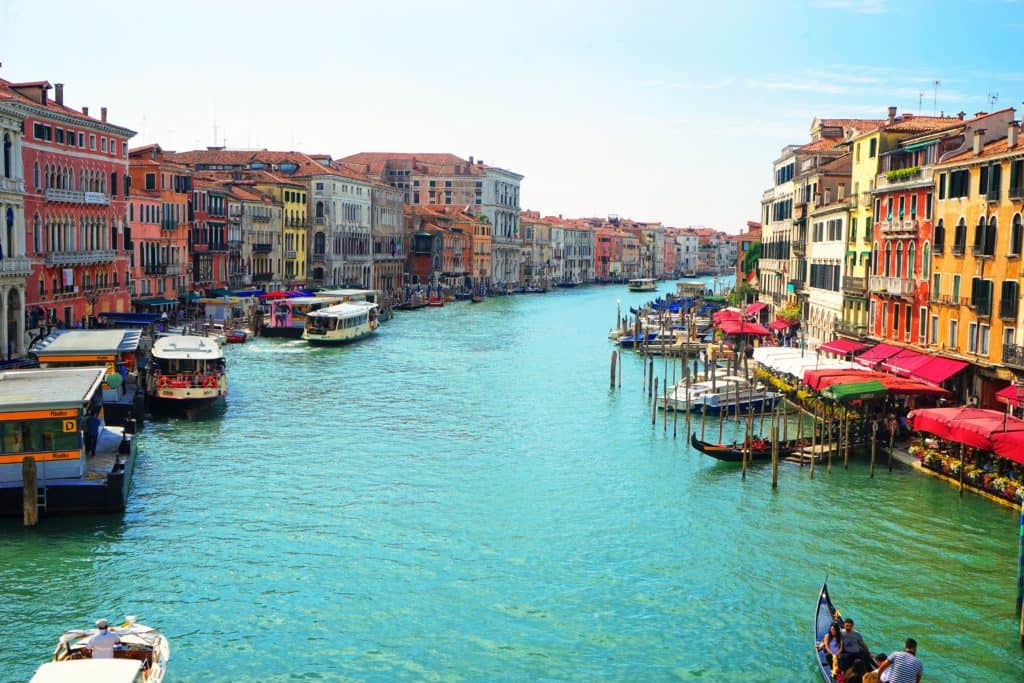
Get Oriented With Venice
Venice is divided into six neighborhoods, called sestieri, each with their own unique character.
On the northern side of the Grand Canal lies Cannaregio with the old Jewish Quarter, San Marco with Saint Mark’s square, and Castello stretching to the end of the island. On the southern side, Santa Croce is followed by San Polo with its markets, connected to San Marco by the Rialto bridge, and Dorsoduro with its museums.
Each district has its own distinctive feel, and I recommend that travellers find some time to get away from the normal tourist routes and make their way into the areas of the city that locals frequent. Give yourself the opportunity to make your own discoveries away from the tried-and-true path to Saint Mark’s Square.
Cannaregio’s Jewish Museum offers tours of the old synagogues. Castello has the Arsenale and the Venice Naval History Museum. San Polo has the produce and fish markets to explore, and Dorsoduro has artistic attractions like the Guggenheim Museum and the Punta della Dogana.
There’s so much to see in Venice that you could easily spent weeks exploring its alleyways and neighborhoods.
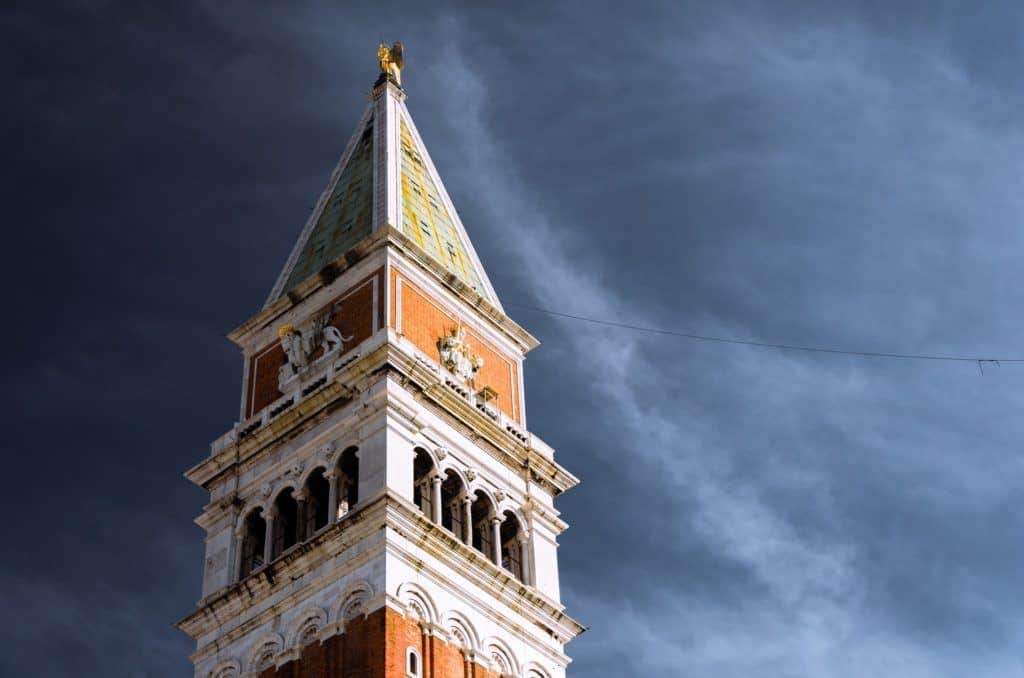
Top Sights in San Marco
The year 2021 marked 1600 years since the city’s founding. History surrounds you from the moment you leave the train station behind and see the Grand Canal for the first time. To get the best sense of Venice, once you’ve settled in, follow the flow of people through the narrow winding streets to Piazza San Marco. Or start your explorations from the water by boarding vaporetto line 1 to take the full trip down to the Square.
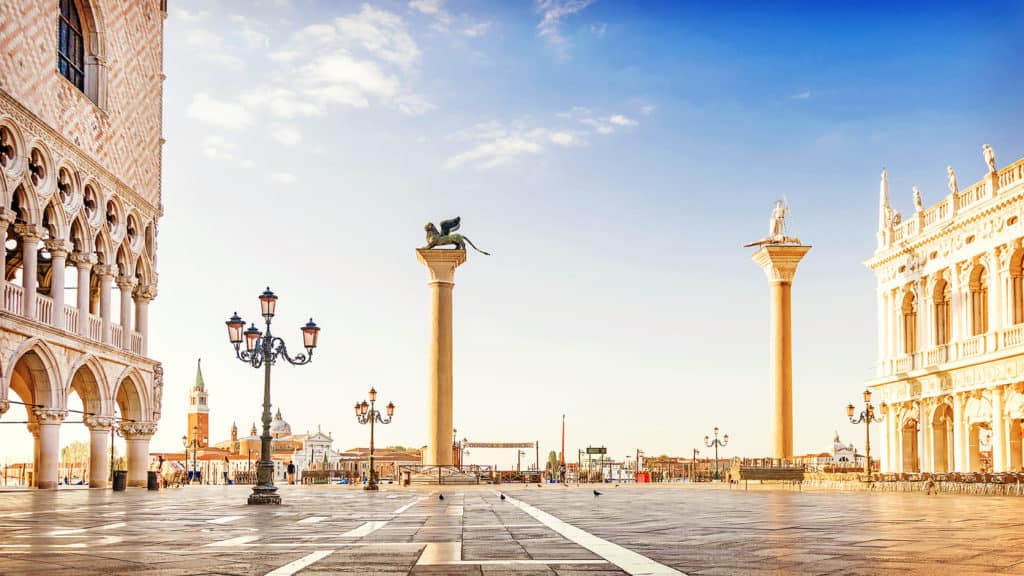
St. Mark’s Square
One of the most stunning squares in the world, Saint Mark’s is enclosed by a beautiful series of arcaded buildings on two sides, and faces the gorgeous Saint Mark’s Basilica with its cupolas and bell tower and the elaborate architecture of the Doge’s Palace.
Soak in the scenery and watch the tourists and pigeons filling the square. To avoid the crowds, consider an early morning or late evening visit, when the square is magical in its quiet. But do splurge on an aperitif at one of the two famous cafés on the square, Caffe Florian, the oldest in Europe from 1720, or Quadri, a latecomer from 1775. Note that when the orchestra is playing, there will be a cover charge of €6 per person to sit outside.
At the waterfront are two tall columns, one of the winged lion of Saint Mark, patron saint of the city, the other of St. Theodore, the city’s first patron, with his dragon. From here the view of the lagoon and the docked gondolas are stunning, and you can stroll along the waterfront promenade of the Riva degli Schiavone.
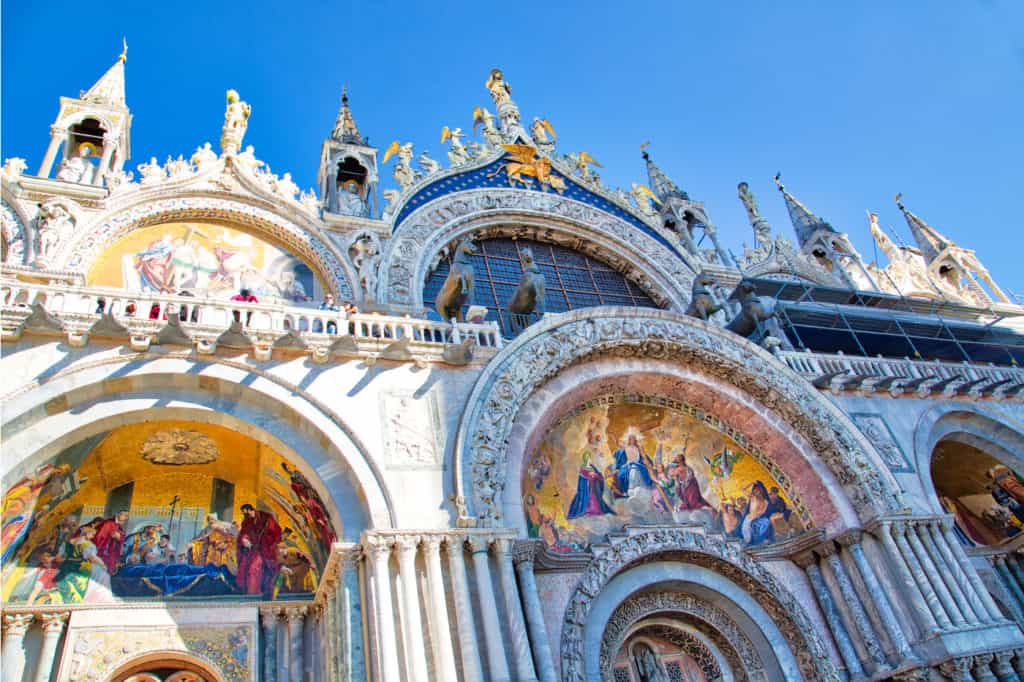
Saint Mark’s Basilica
This is Venice’s most glorious church, founded in the 9th century to serve as the burial spot for the body of Saint Mark. With its oriental Byzantine appearance, it is a tribute to the days when Venice was a trading power and made conquests in the east. This influenced the design of the basilica with its amazing mosaic work from the late 12th and 13th centuries, and the ancient bronze Roman horses that were taken from Constantinople in 1204 (replicas now appear outside and the originals are in the Basilica’s Museum). Inside the highlights beyond the mosaics included the gem studded Pala D’Oro screen and the tomb of Saint Mark.
The base cost to visit the basilica is 3 euro, with supplemental charges of 5 euro to see the Pala d’Oro and 7 euro to visit the museum with the famed horses.
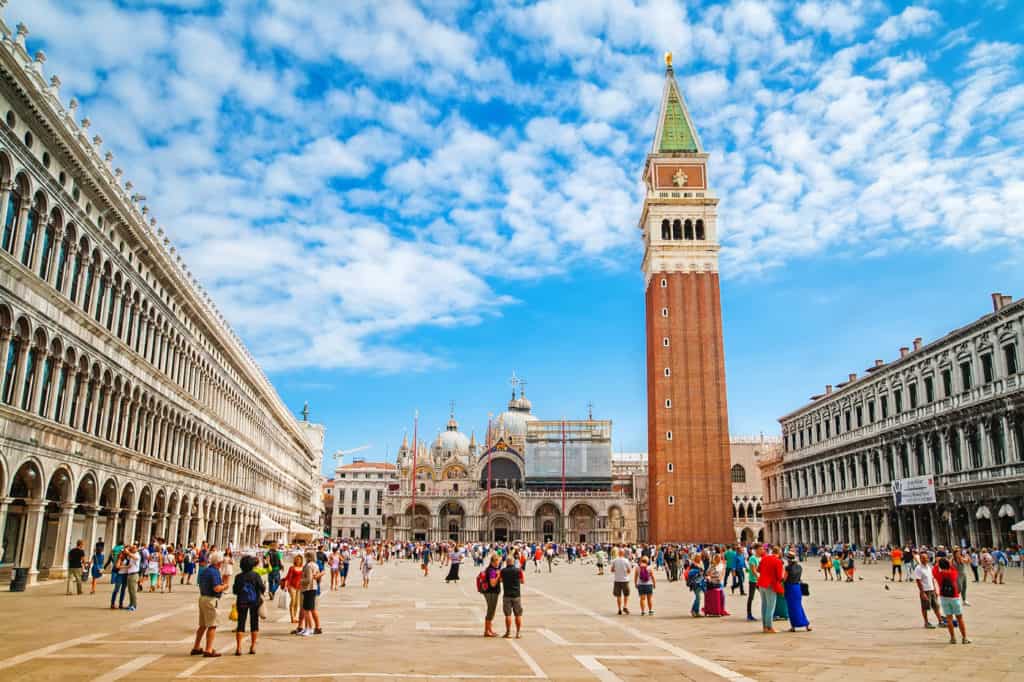
St. Mark’s Campanile
Take the elevator to the top of the 325-foot bell tower for sweeping views of the Square and out over the city and lagoon. The current tower replaced the previous 12th century campanile that collapsed in 1902. Galileo tested his telescope here in the 1500s. The price to enter is 8 euros, unless you opt to pay more for the skip the line ticket which provides you a specific arrival time.
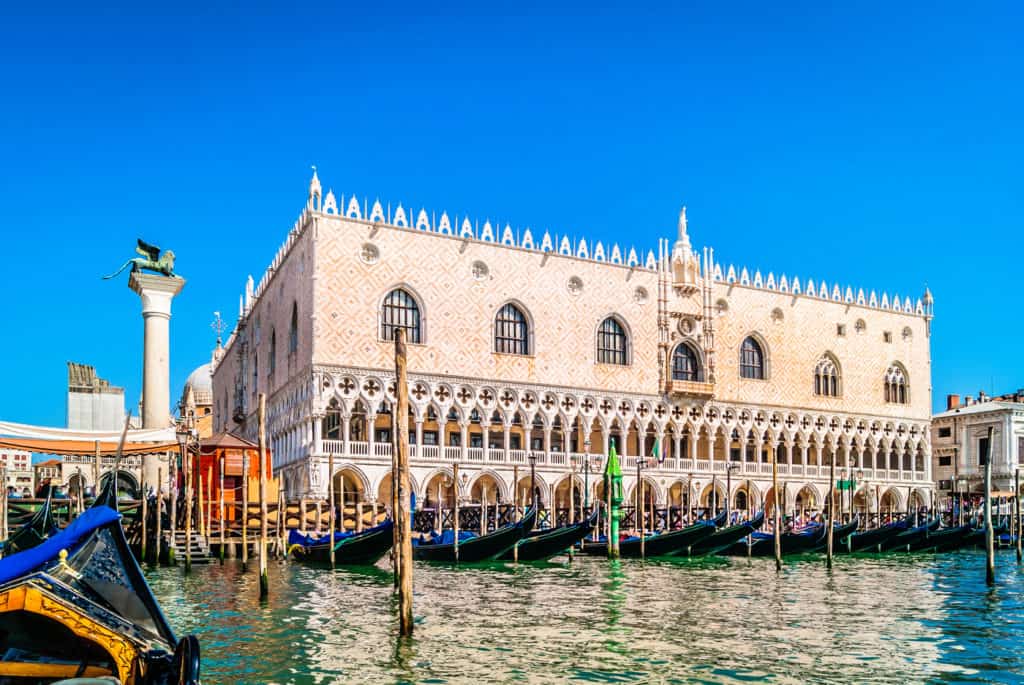
Doge’s Palace
Venice was once ruled by the Duke or Doge of Venice, and this was their seat of power, built to awe with its elaborate decoration, ceiling frescoes and rich exterior and interior ornamentation. It was where the legislative functions of the city occurred, and the building is connected to the prison via the famous Bridge of Sighs. The standard tour, which costs 26 euros, allows you to see the courtyard and chambers and the frescoed walls and ceilings from some of Venice’s most illustrious painters such as Tintoretto and Veronese. To dig deeper into the palace’s passageways and be able to actually cross the Bridge of Sighs, book the Secret Itineraries Tour which costs 28 euro per person for the 1 hour 15 minute tour.
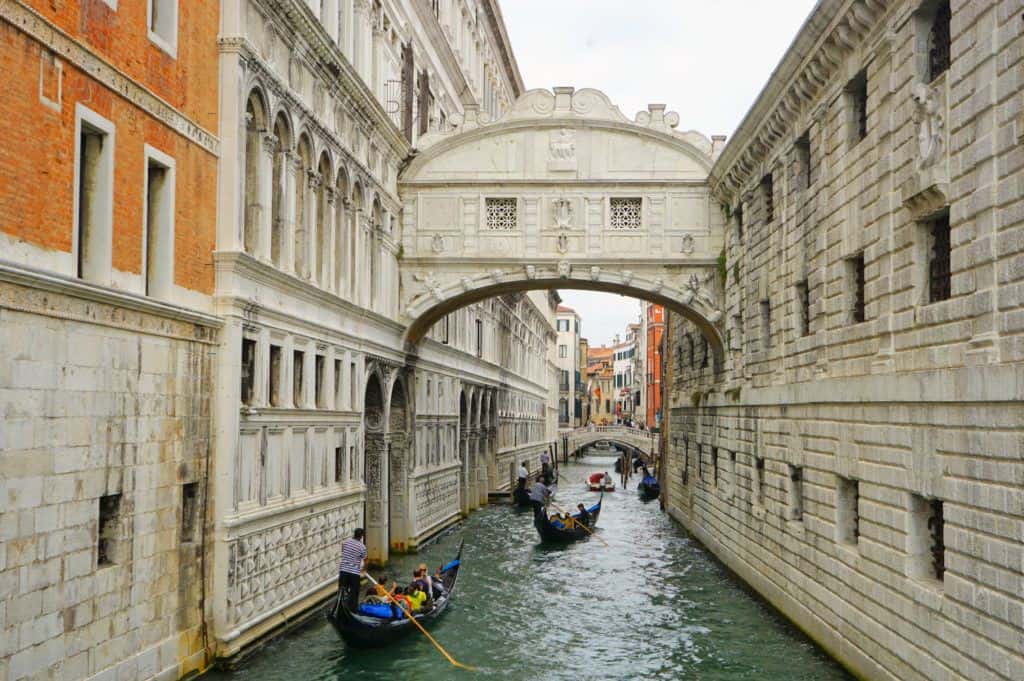
Bridge of Sighs
High above the water is suspended the enclosed marble Ponte dei Sospiri (Bridge of Sighs), named for the cries of the condemned prisoners who got their last views of freedom from the windows of this bridge. The best view is from the Ponte della Paglia, on the Riva degli Schiavoni on the waterfront behind the Palace.
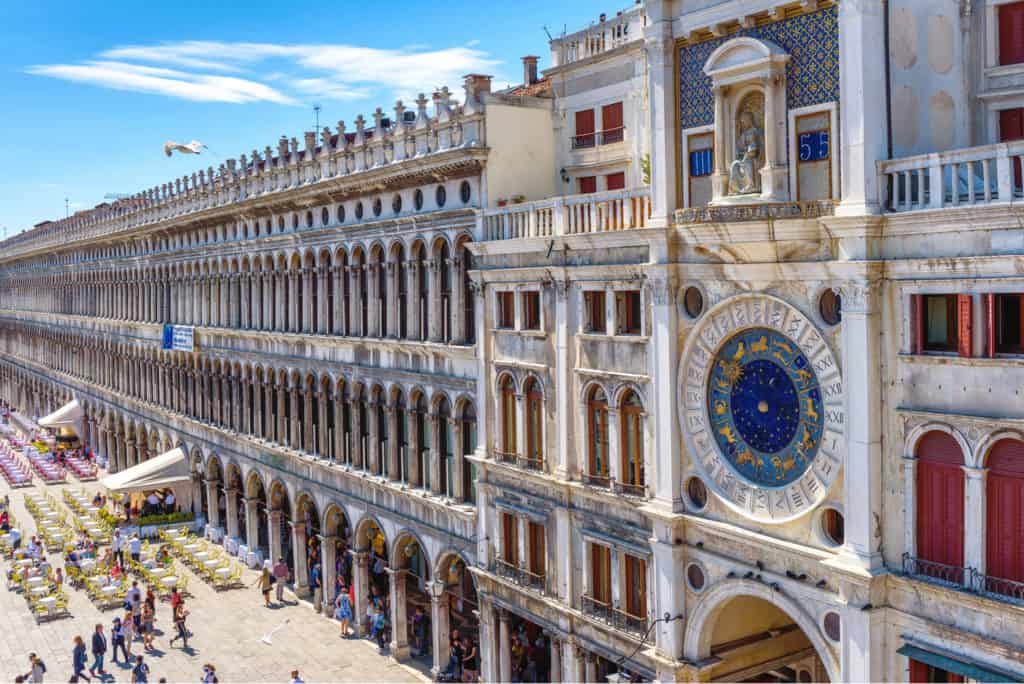
Torre dell’Orologio
This enameled clock from 1499 features two large bronze figures now referred to as the Moors because the bronze has tarnished over the centuries. They strike the hours and the large clockface below makes for a good photo opportunity. The inscription on the tower reads “I only count the happy hours”. Visits are by guided tour and cost 13 euros, and reaching the top requires climbing four stories of steep spiral staircases, so be forewarned!
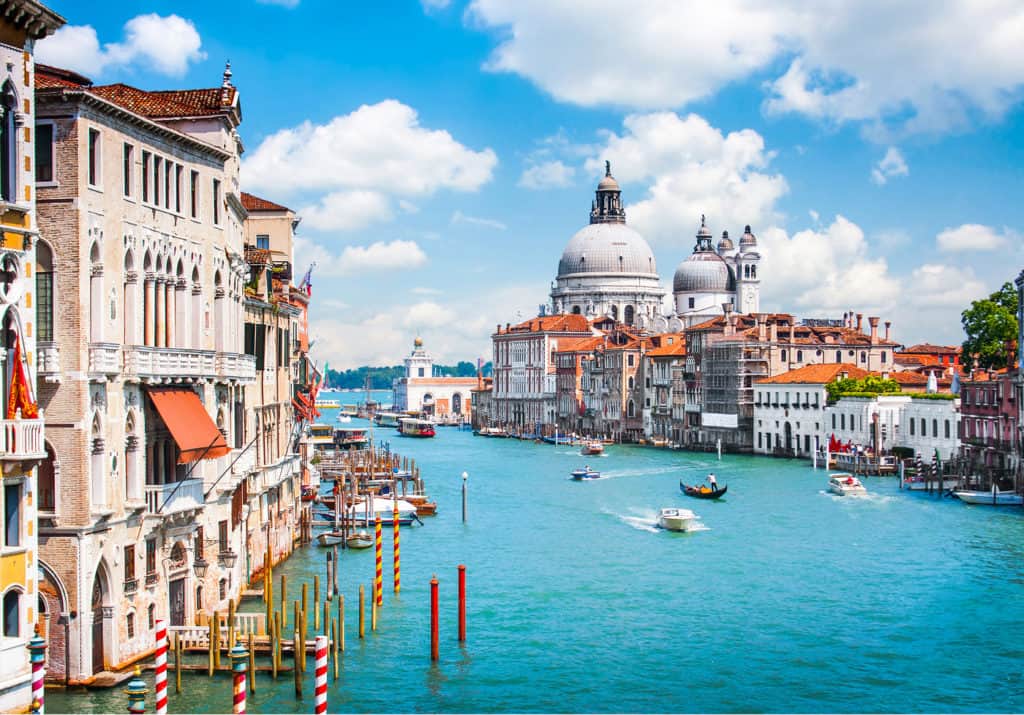
Grand Canal
The majestic Grand Canal is the magical heart of the city, coursing past the palazzi and churches that line its banks in an inverted S curve as it sweeps from the train station exit down to Saint Mark’s Square. It is a must-take excursion to take the full ride, enjoying the views of water traffic, gondoliers plying their craft, and the beautiful arch of the Rialto bridge.
The most common way to make to trip is via the boast called vaporetti, the main public transportation run by the city. Line number 1 goes the full distance, stopping at stations along the way. The cost of an individual ticket is 7.50 euros, or 20 euro for a 24-hour pass, 30 euro for a 48-hour pass. If you plan to travel often using the vaporetti, consider the purchase of a Venezia Unica City Pass for 27.90 euros. These boats can be very crowded during the day, so consider an evening excursion to best appreciate the trip and the sights. The boats run from 6 a.m. to 10 p.m.
Gondola rides are much pricier and are more enjoyable for exploring the quieter side canals, particularly in the evening when the lights come on inside the palaces and the lanterns light up on the bridges. Prices are set by the city, starting at 80 euro for a 30-minute ride for up to 6 people, rising to 100 euro for rides after 7 p.m.
Since there are only four bridges along the 2-mile-long Canal route, there are also simplified gondolas called traghetti that simply make the crossing from one side to the other at specific points.
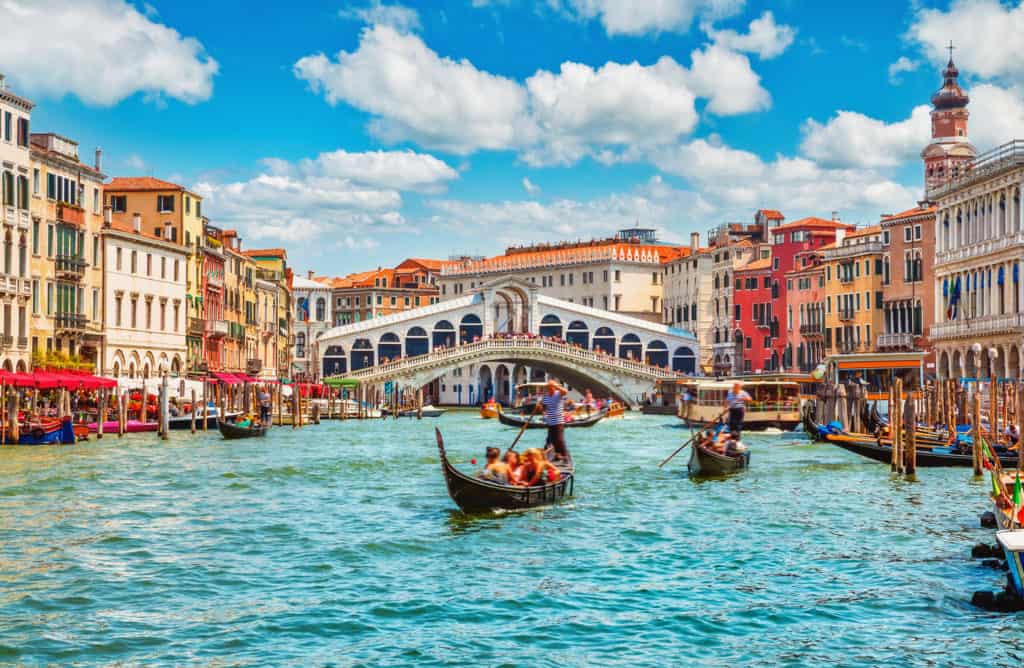
Rialto Bridge
The Rialto is the city’s most famous and photogenic bridge, built from 1588-1591. It connects the San Marco area with the San Polo district with its food and fish markets. There are shops built atop the bridge, which affords spectacular views of the Grand Canal from its railings. The architect, Antonio da Ponte, beat out such luminaries as Michelangelo for the job, and designed the bridge to include retail space and to be tall enough to allow Venetian galleys to pass underneath.
Day Trip Out to the Islands of Venice
The Venetian lagoon contains more than 100 islands, but these mentioned below are most worthy of your attention even if you have limited time on your trip. You can visit any of them by taking a vaporetto ride.
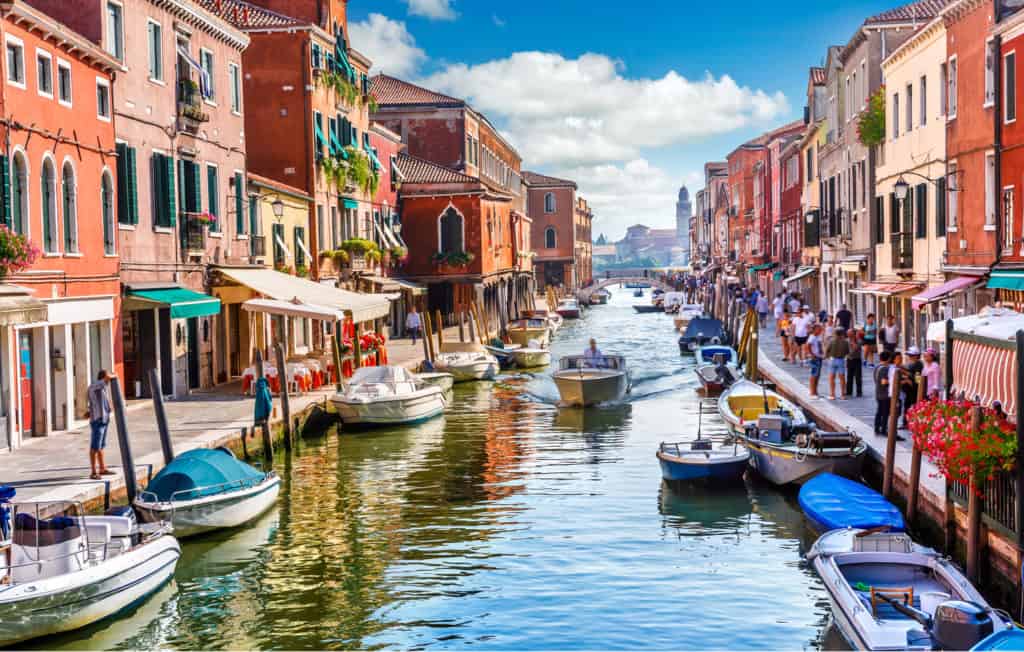
Murano
Murano maintains a thousand-year-old glassmaking tradition. Visit here to see the glassblowers at work and perhaps purchase a glass souvenir to take home. There is also the Glass Museum that covers the history of this craft. Tickets cost 11 euro per person. Take the 4.2 Vaporetto from Saint Mark’s Square.
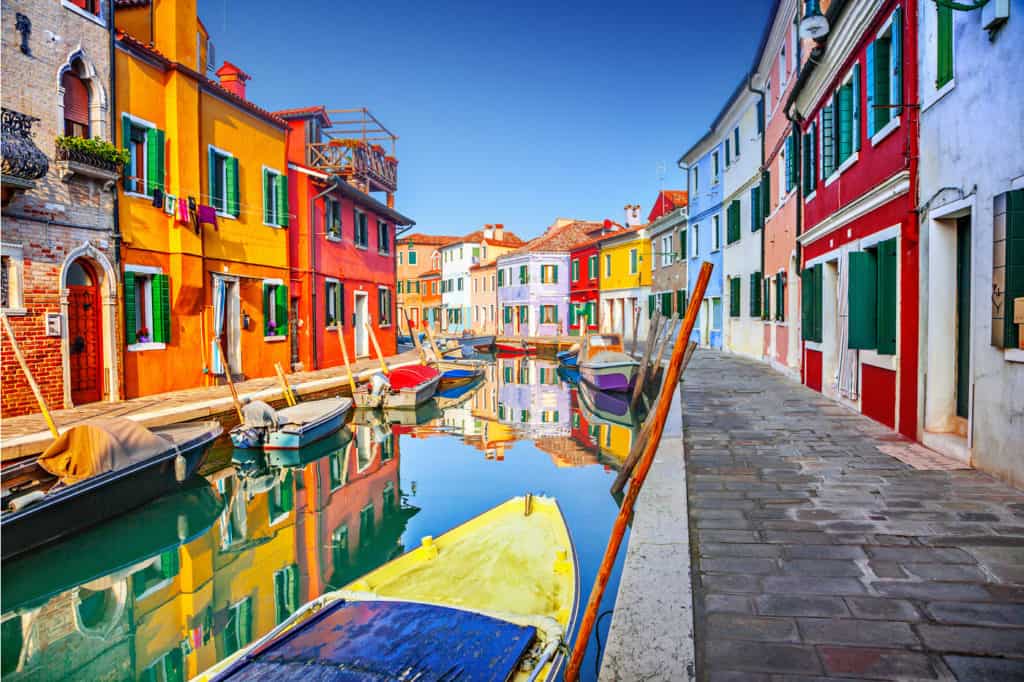
Burano
Burano is well known for its lace making tradition and for its colorfully painted houses in a rainbow of colors. The island’s Lace Museum covers the history of this industry. The entry ticket is 6 euro per person. Burano is a 40-minute vaporetto ride from the city, via the number 12 line from stop Nove A in Cannaregio. Also look for the Church of San Martino, which has a leaning campanile of its own!
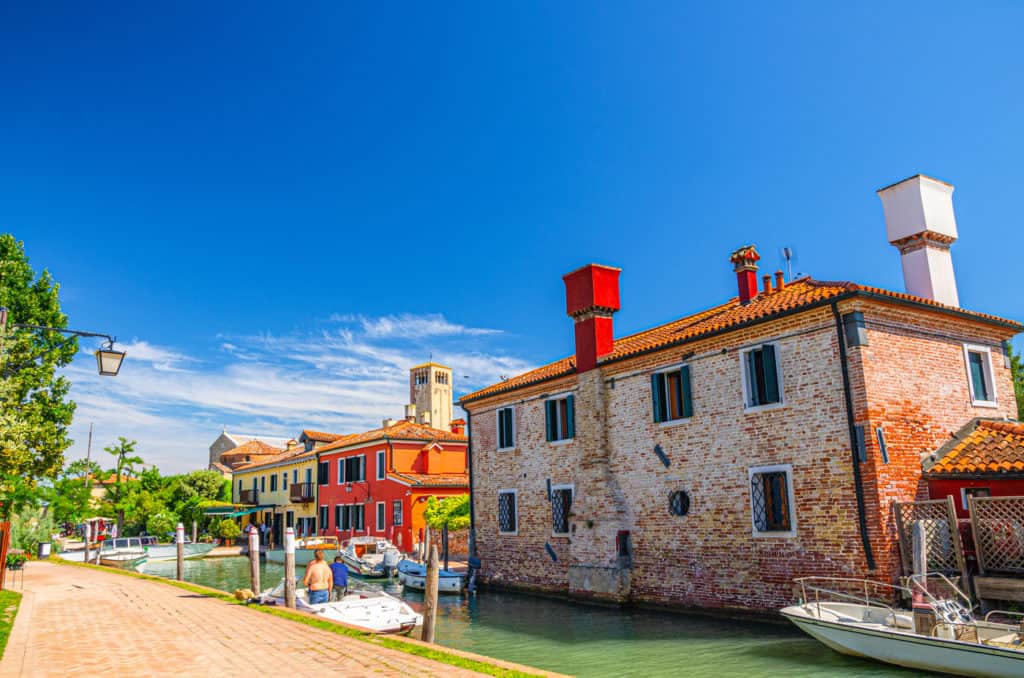
Torcello
Prior to the founding of Venice, Torcello was the original settlement in the Venetian lagoon. Settlers fleeing the barbarians first settled on Torcello, before ultimately moving to what is now considered the Venetian mainland. The Torcello Cathedral, named Santa Maria Assunta, was built in 639 AD and is the oldest building in Venice. Its chief attribute is the brilliant Byzantine mosaics from the 11th century.
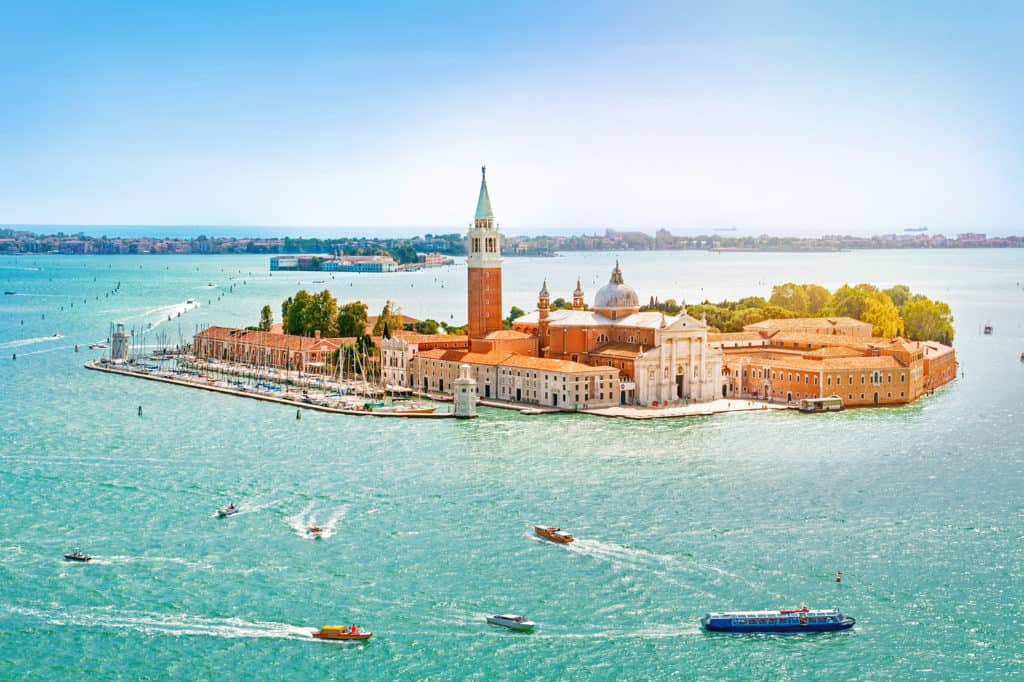
San Giorgio Maggiore
San Giorgio Maggiore is both an island unto itself and the name of a striking Benedictine church that can be seen across the lagoon from the waterfront of Piazza San Marco.
The best feature is the bell tower, which can be ascended to get some of the most amazing views back across the lagoon of Venice. The cost for the tower elevator is 3 euro but do be warned that the tolling of the bell is quite loud if you find yourself near it at the top of the hour! The church itself may be entered for free and contains two of Tintoretto’s later works.
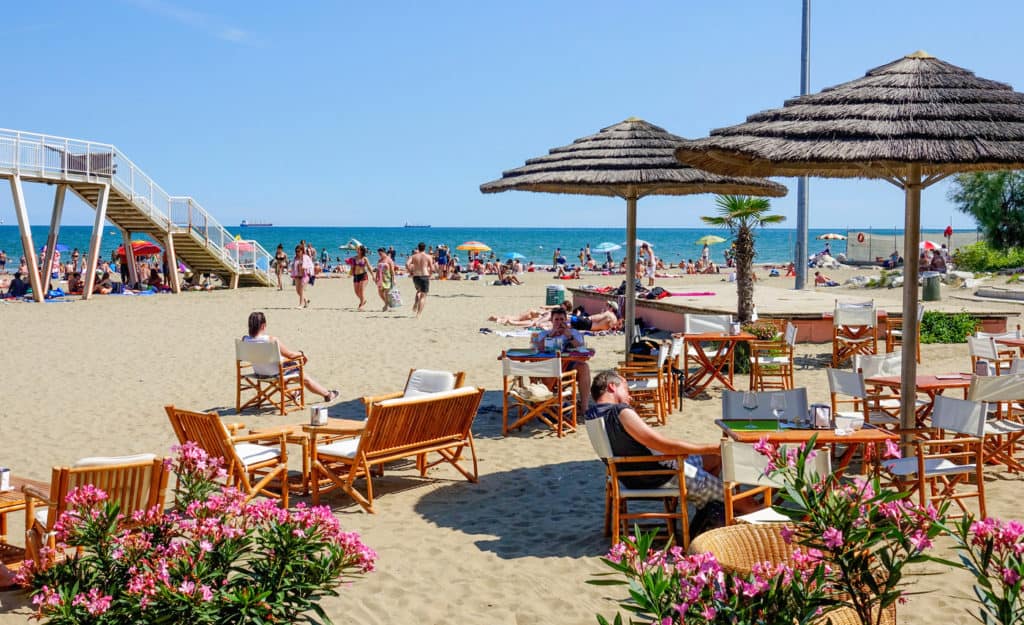
Lido
For those who would like to sample the local beach scene, most vaporetto lines will take you on the 30-minute ride from San Marco. There are bathing establishments to rent beach items and The Venice Film Festival is held here every September.
Museums
Venice is a world-class art city, with collections ranging from the classical masters of Venetian painting to modern art. Often the collections are housed in striking waterside palazzi that offer wonderful art inside and fabulous views outside of the city and Grand Canal. Here are some of the very best museums to visit by type of art.
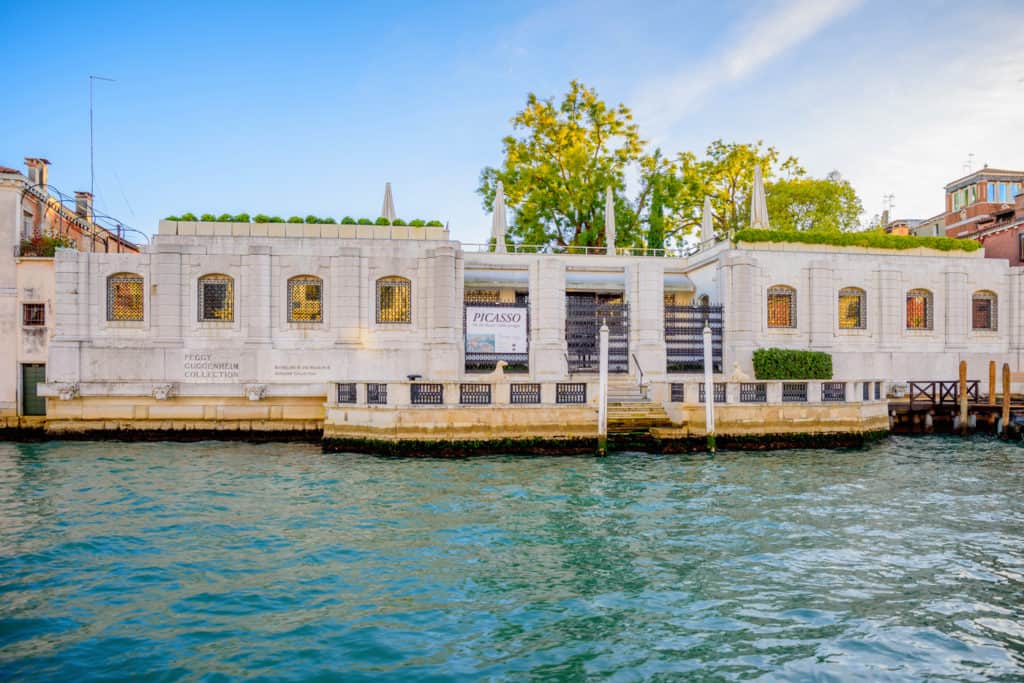
Modern Art Collections
Peggy Guggenheim Museum
The Guggenheim is one of the best private art collections of modern art in the world. Founder Peggy Guggenheim purchased a partially completed Grand Canal palazzo and filled it her with collection of modern art, featuring such masters as Dali, Picasso and Pollock. Situated in the quiet Dorsoduro district, this collection is one of the city’s best. The museum’s entry ticket costs $16.50.
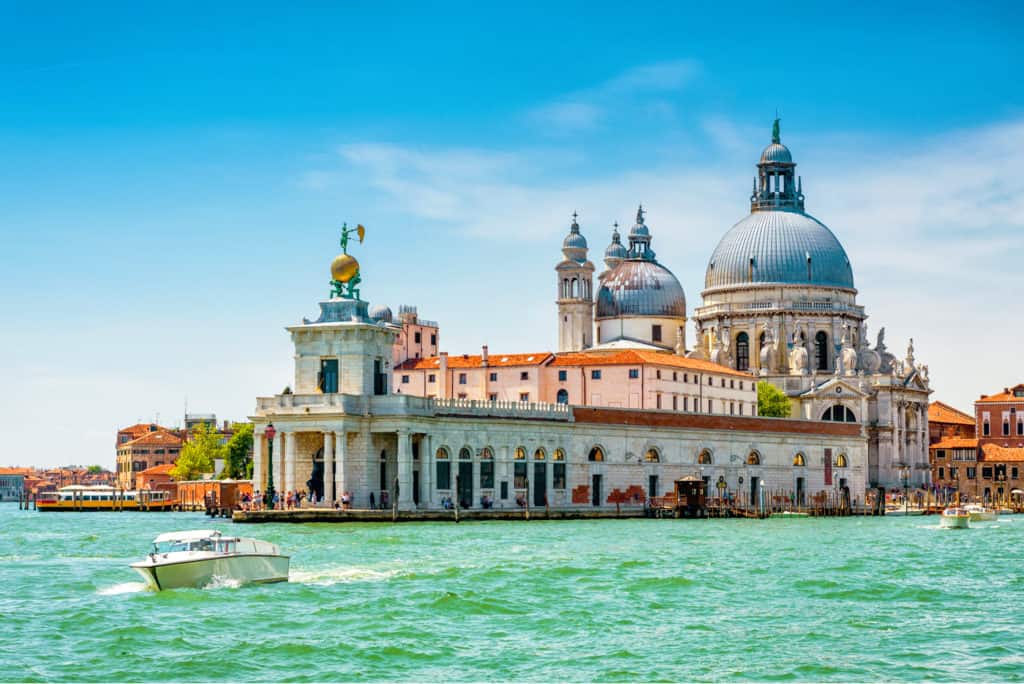
Punta della Dogana
This former customs warehouse was rented by French billionaire art collector François Pinault to showcase part of his modern art collection. The space was stunningly reinvented for that purpose by Japanese architect Tadao Ando. The setting at the tip of Dorsoduro is also worthy of a walk to the point for the amazing views. The entry fee is 15 euro.
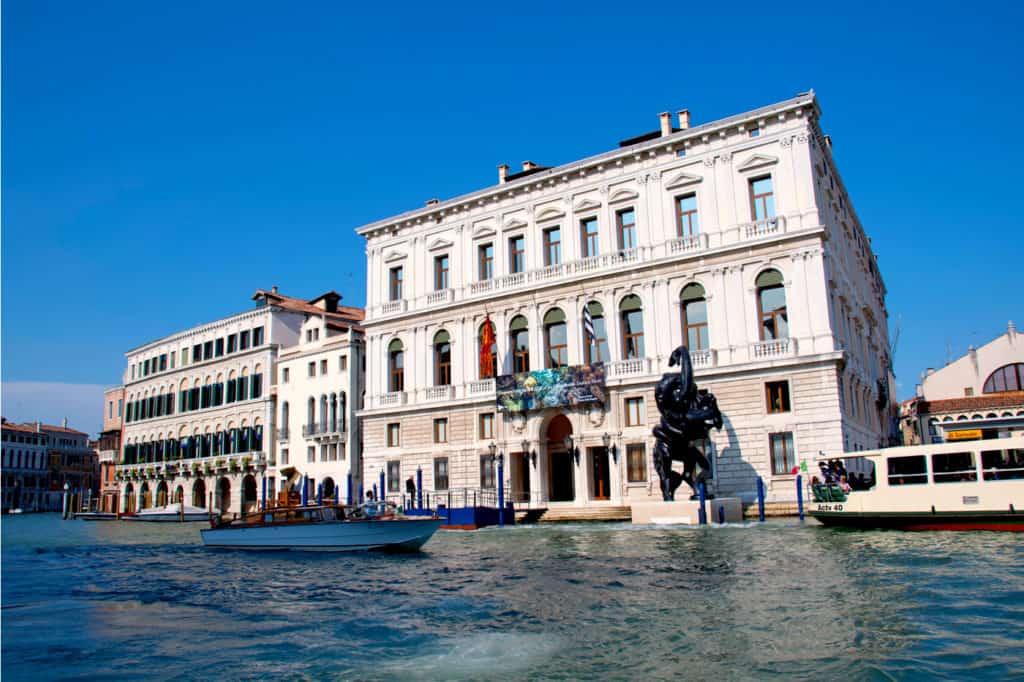
Grassi Palace
Pinault also owns this four-story canal side palazzo and mounts changing exhibitions from his modern art collection, including works by Jeff Koons and Damien Hirst. The regular entry fee is 15 euro.
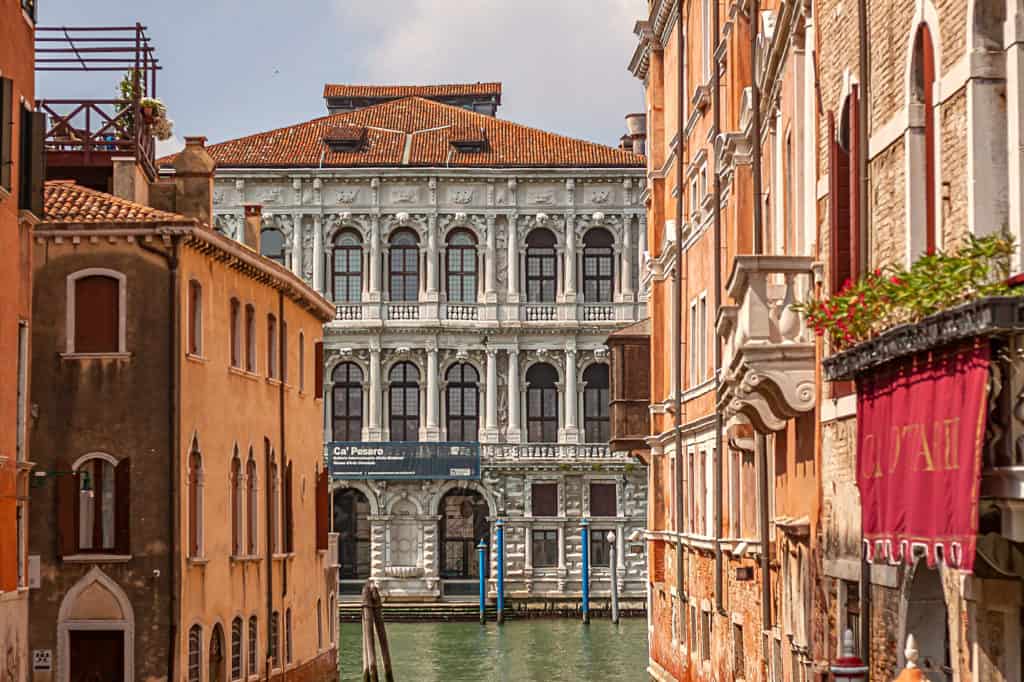
Ca’ Pesaro International Gallery
Ca’ is short for the Venetian word for casa or “house”. This elaborate palace on the Grand Canal was built in the 17th century by the Pesaro family. It houses two collections, The Galleria Internazionale d’Arte Moderna with modern works by such artists as Miró, Matisse and Klimt and a collection of works from the Venice Biennale. The Museo Oriental showcases Japanese art of the Edo period. The entry fee is 11 euro.
Classic Art
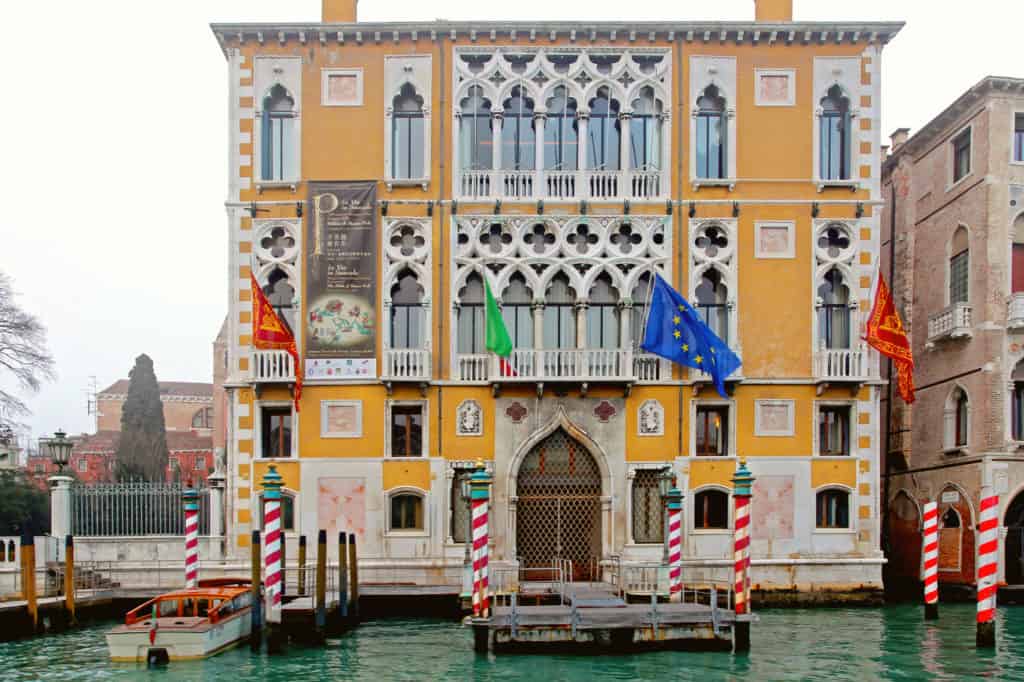
Galleria dell’Accademia
This famous collection presents the best of Venetian art from the 13th through the 19th centuries in a panoramic presentation. Masters on display include Bellini, Titian, Tiepolo and Canaletto. The museum can get very crowded, so consider booking ahead with a timed ticket. The basic ticket costs 12 euro.
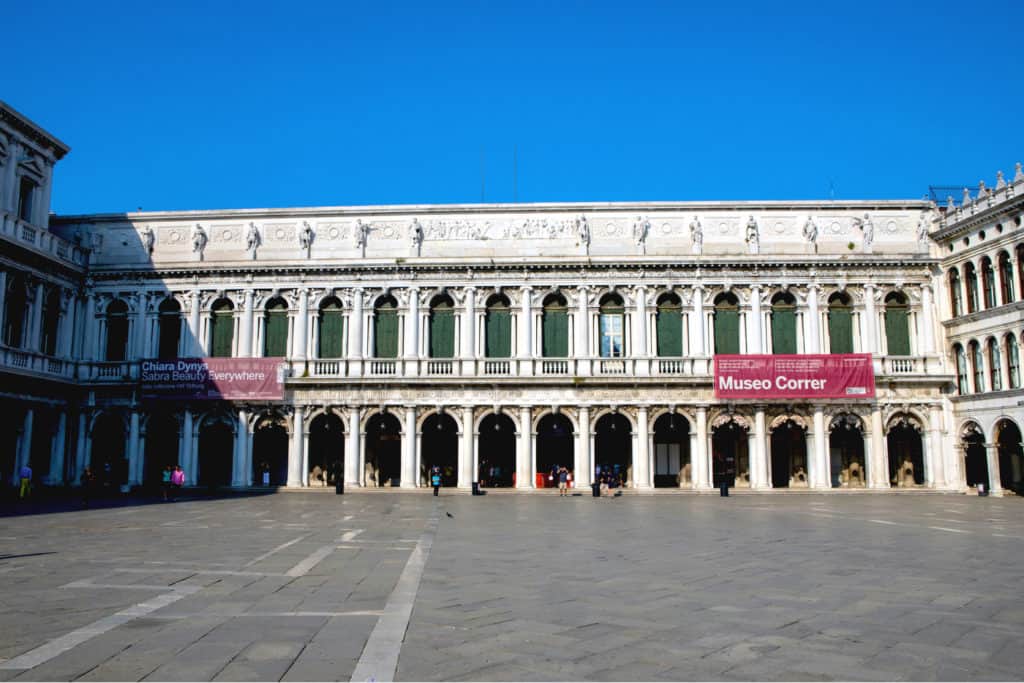
Museo Correr
Venetian art and history are covered in this engrossing museum, which also contains a sculpture collection by Canova and well-known paintings by Bellini and Carpaccio and other local artists. The entry fee is 25 euro.
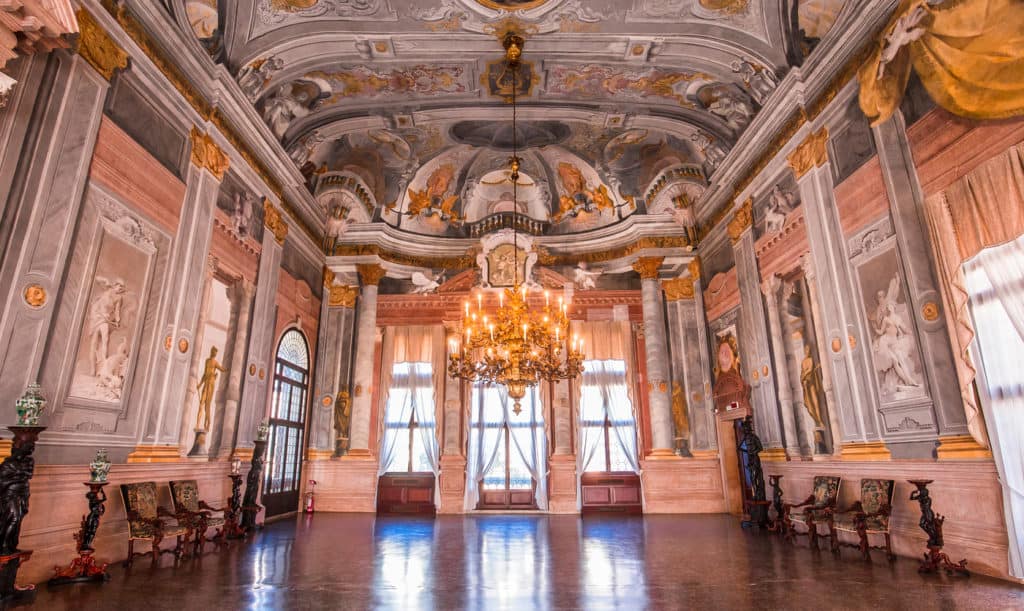
Ca’ Rezzonico
The spectacular centerpiece of this canal side palazzo is the magnificent Grand Ballroom. Today the upper floors house the Museo del Settecento (Museum of Venice in the 1700s). The main floor reflects the appearance of a magnificent Venetian palazzo, with period furniture and tapestries in its salons. The entry fee is 11 euro.
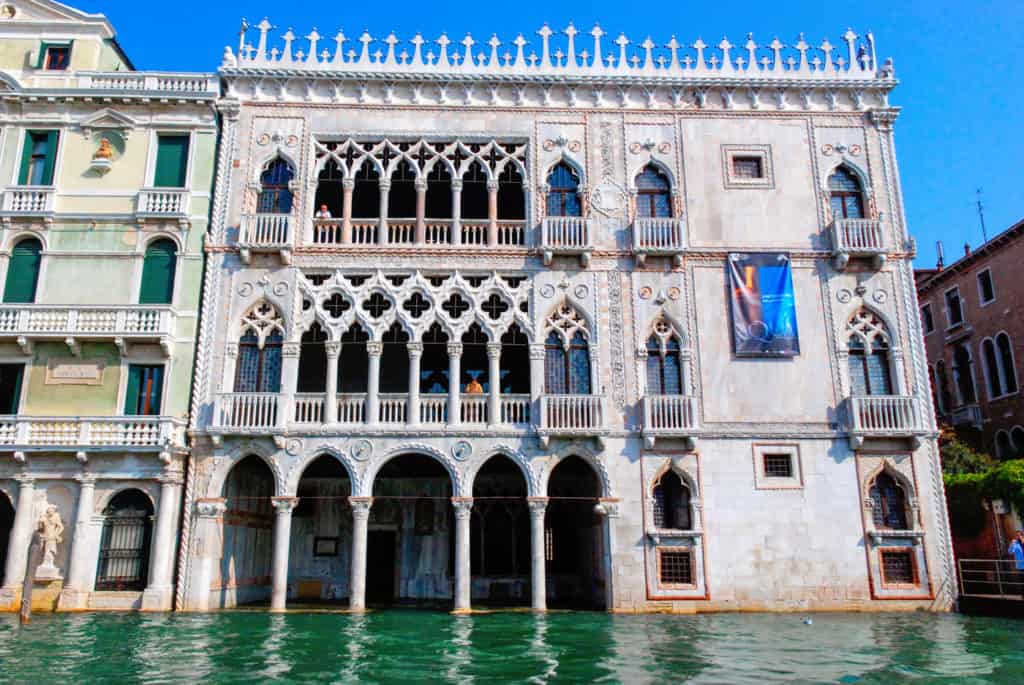
Galleria Giorgio Franchetti alla Ca’ D’Oro
Originally decorated with gold leaf that gave the building its name, Ca’ D’Oro is one of the most beautiful buildings on the Grand Canal. In addition to housing a collection of artistic masterpieces, the views from the balconies are sublime! The entry fee is 6 euro.
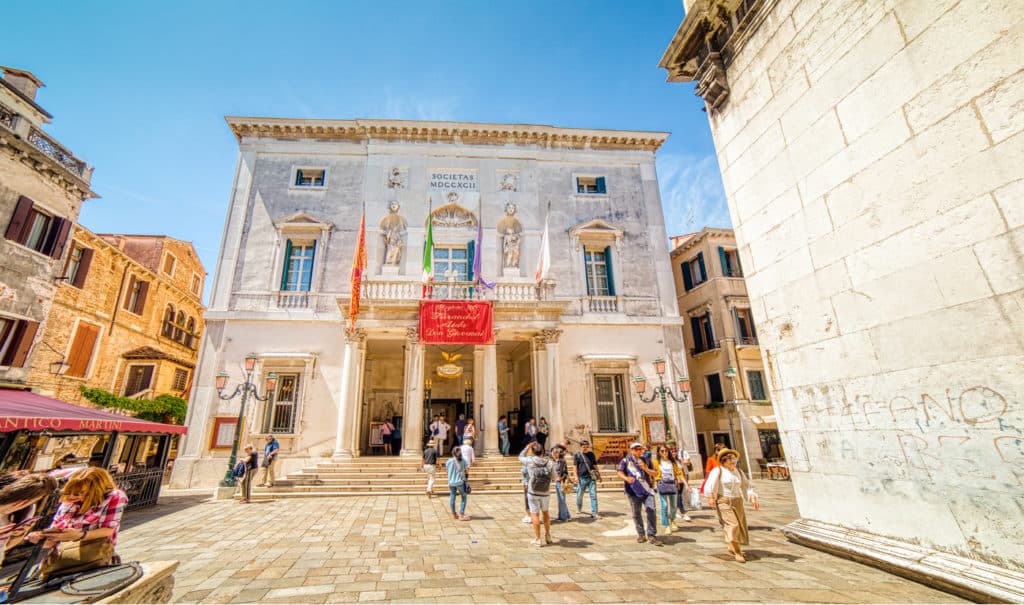
Teatro La Fenice
Though not a museum, this concert venue and opera house is one of the city’s architectural and cultural treasures. Some of the most famous operas in history have premiered on this stage. Like its name the Phoenix, it has risen from the ashes of fires three times in its past, most recently in 1996. The season runs from June through October.
Churches
Many of the masterpieces of the Venetian school painters can still be seen in their original settings in Venice’s amazing churches.
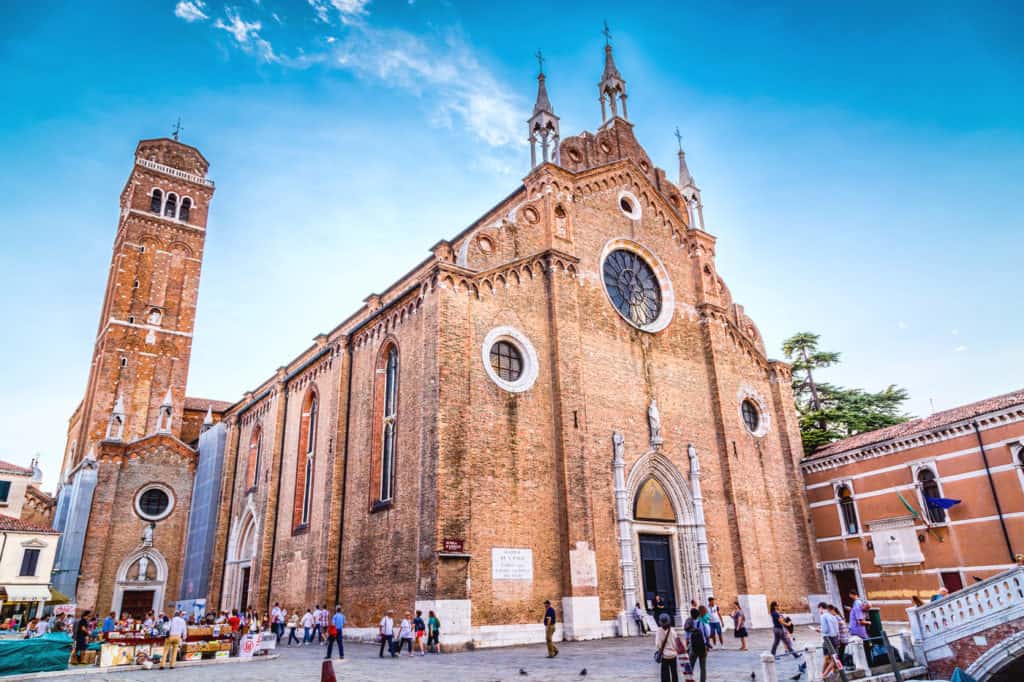
Basilica Santa Maria Gloriosa dei Frari
This 1442 Gothic brick church is famous for its array of spectacular Venetian paintings from Bellini, Titian, and Vivarini. The entry fee is 3 euro.
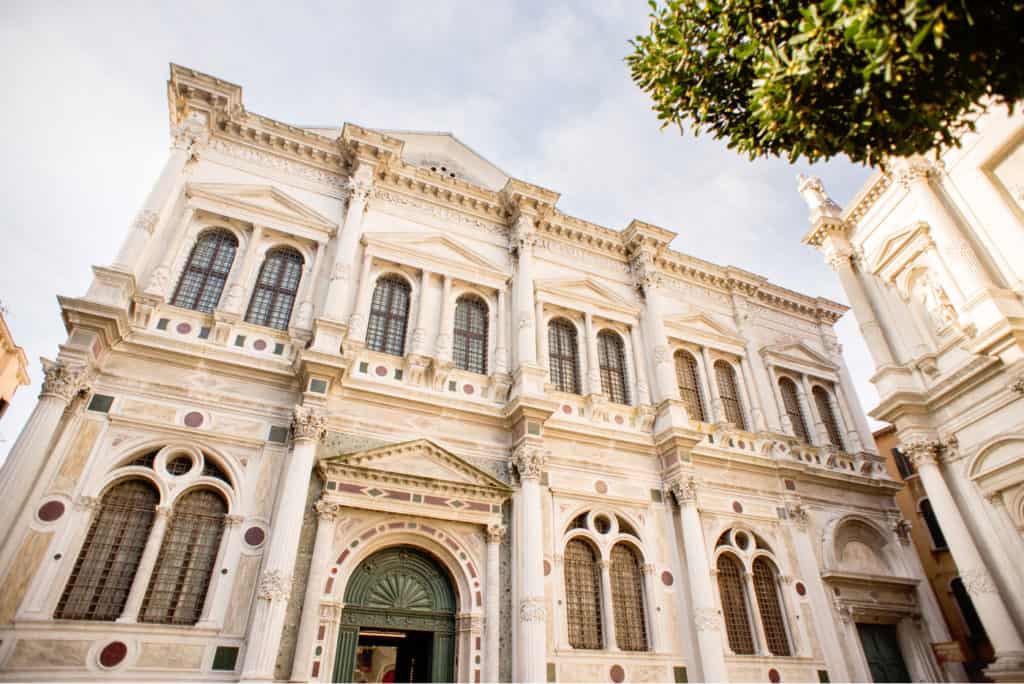
Scuola Grande di San Rocco
Tintoretto produced more than 60 works for his patrons here based on the Old and New Testaments. The entry fee is 10 euro.
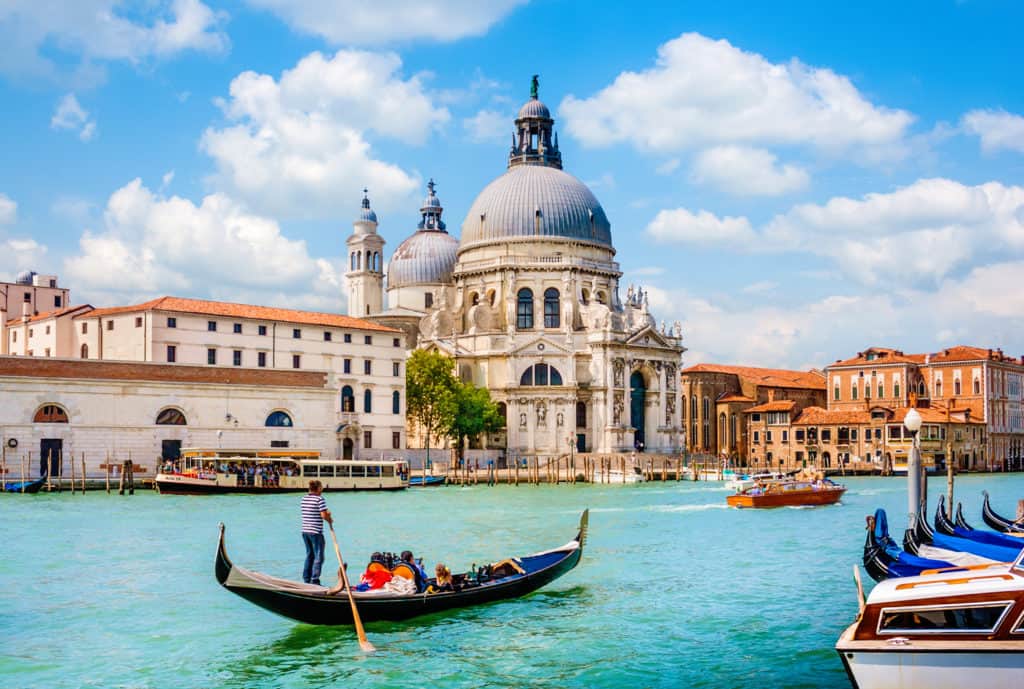
Basilica di Santa Maria della Salute
La Salute was built as a shrine honoring the Virgin Mary for saving Venice from a plague. Be sure to visit the Sacrestia Maggiore, which contains a dozen works by Titian. Though entry to the church is free, there is a 4 euro charge to visit the sacristy.
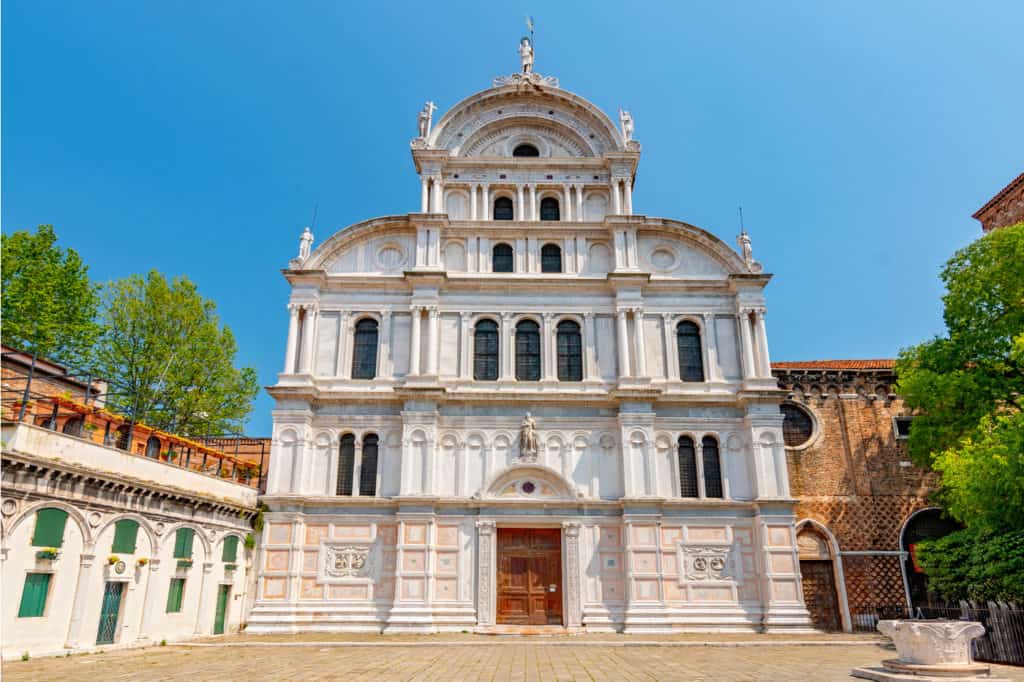
Chiesa di San Zaccaria
San Zaccaria has a notable Renaissance façade and contains Giovanni Bellini’s celebrated altarpiece, La Sacra Conversazione.
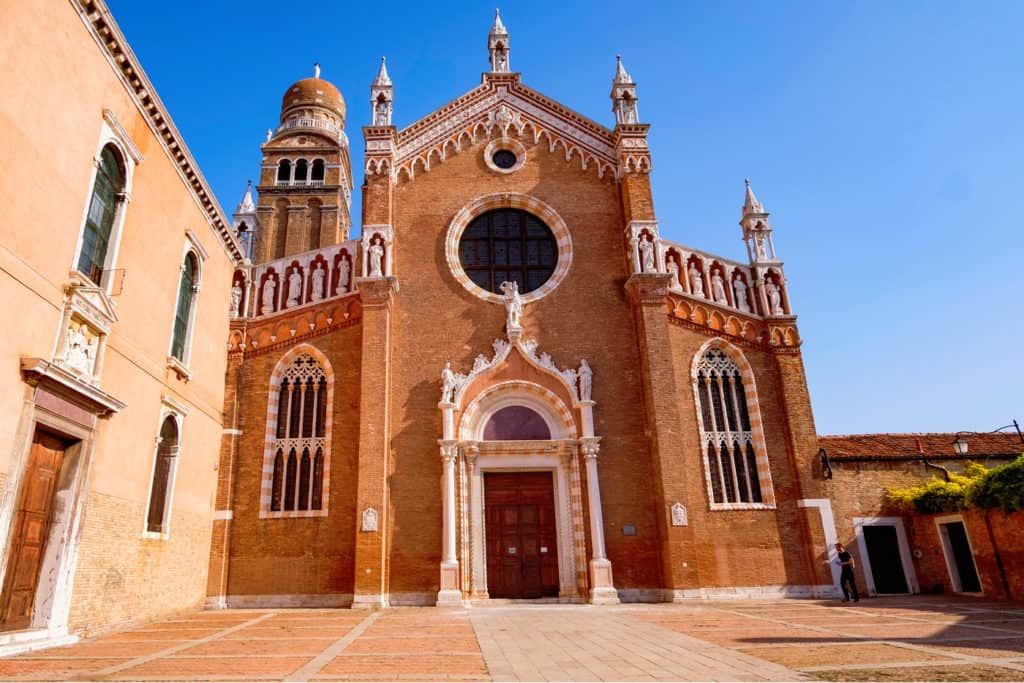
Church of Madonna dell’Orto
One of the most beautiful Gothic churches in Venice, it contains some of Tintoretto’s best work.
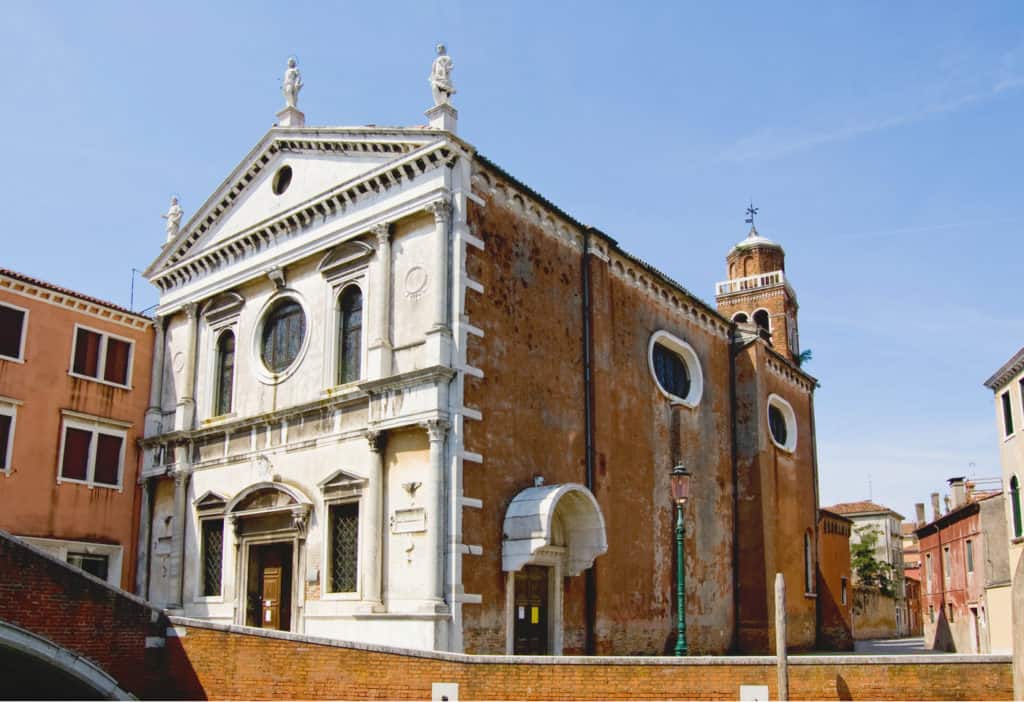
Church of San Sebastiano
Some of Venetian master Paolo Tiepolo’s greatest works can be found in this setting.
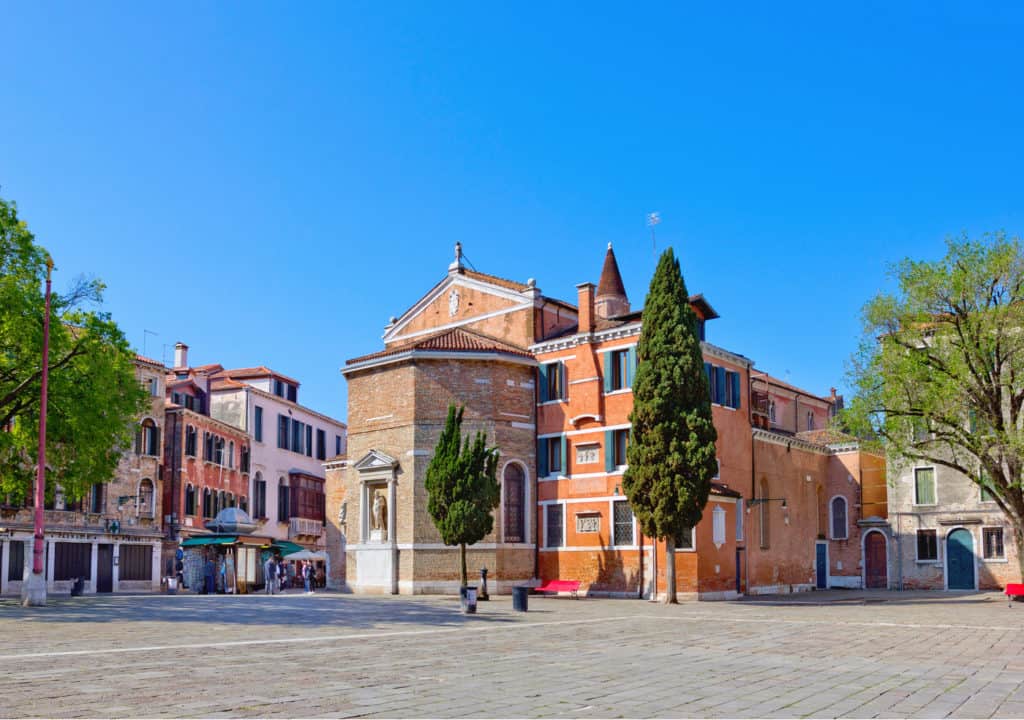
Church of San Polo
Though the church has an unassuming exterior, it houses great works of art such as Tintoretto’s Last Supper from 1569 and Tiepolo’s Way of the Cross.
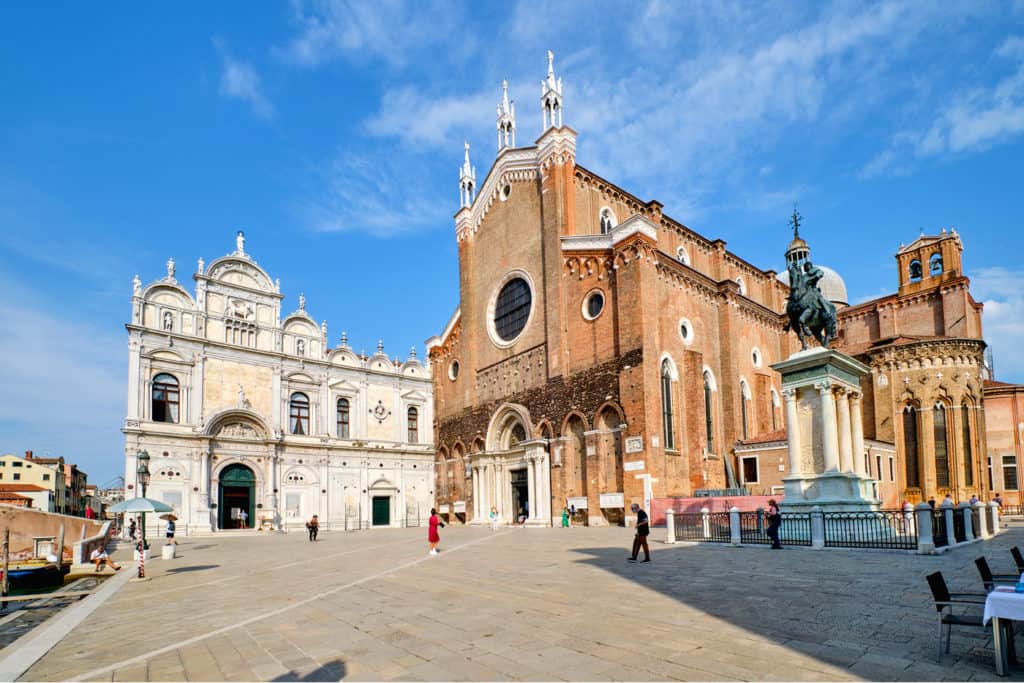
Basilica dei Santi Giovanni e Paolo
This gorgeous church sits in one of the most picturesque squares in Venice, the Campo Giovanni e Paolo. At its center is the 15th-century equestrian statue of Bartolomeo Colleoni by Verrocchio.
Look for the 15th-century stained-glass window from Murano. San Zanipolo also houses the tombs of many important people, including 25 doges.
Tours
There is a wealth of tour opportunities to help you dig deeper into the history and culture of the city, or more conveniently visit surrounding areas or districts where local knowledge is helpful in getting the most out of your experience.
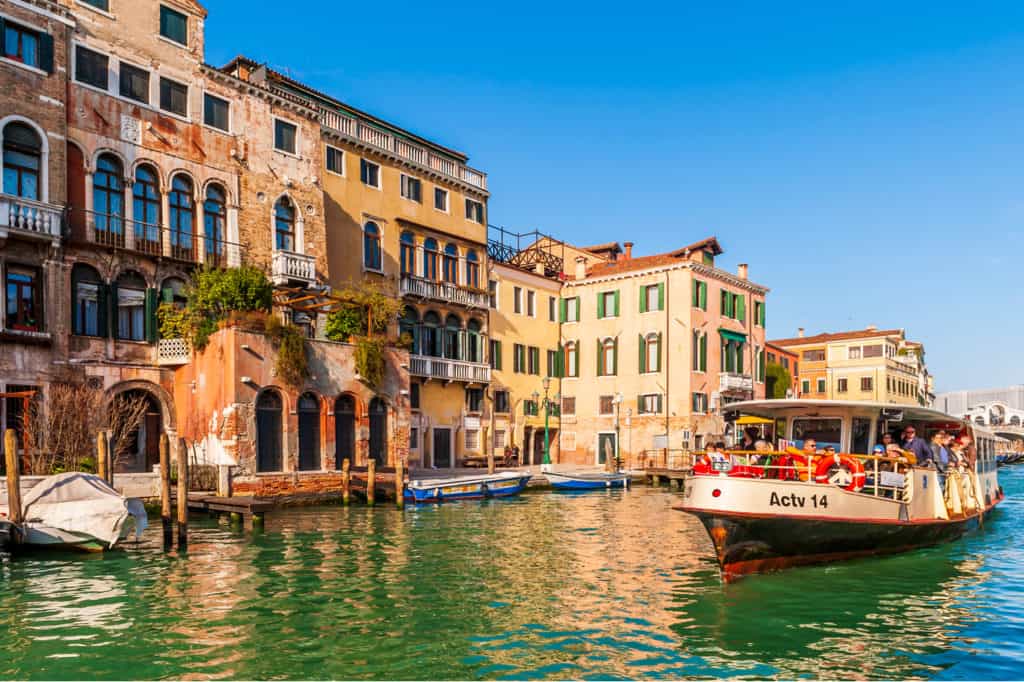
Transportation
- Use this link to purchase vaporetto tickets.
- Private Gondola Ride to Rialto Bridge offers a 30-minute excursion for $141.08 for up to 4 people.
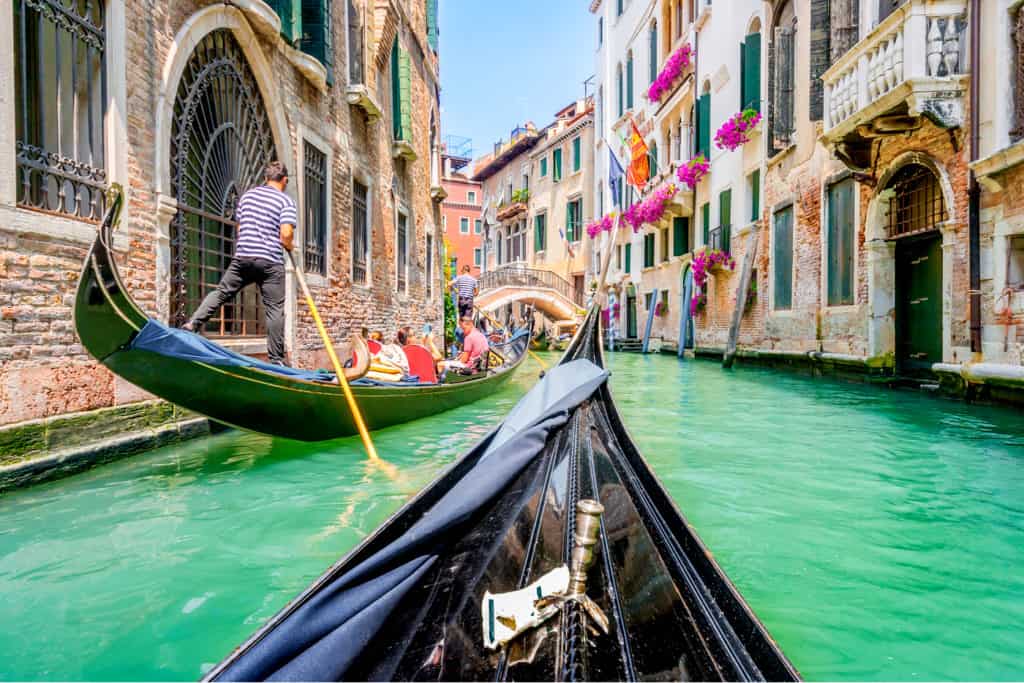
Sightseeing
- Doge’s Palace and St. Mark’s Basilica Fast Track Tour gives you a three-hour guided tour that enables you to avoid the ticket lines for $92.88 per person.
- Peggy Guggenheim Collection Ticket tour lets you skip the line to see this fabulous modern art collection for $21.16 per person.
- Jewish Ghetto Tour with gelato tasting offers a two-hour experience for $76.42 per person.
- This 4-hour tour of the most popular islands of Murano, Burano and Torcello lets you see the best of the lagoon islands for €380 for a group of two.
- Classical Music Concert at Church of San Vidal is a 1.5-hour musical experience for $45.73 per person.
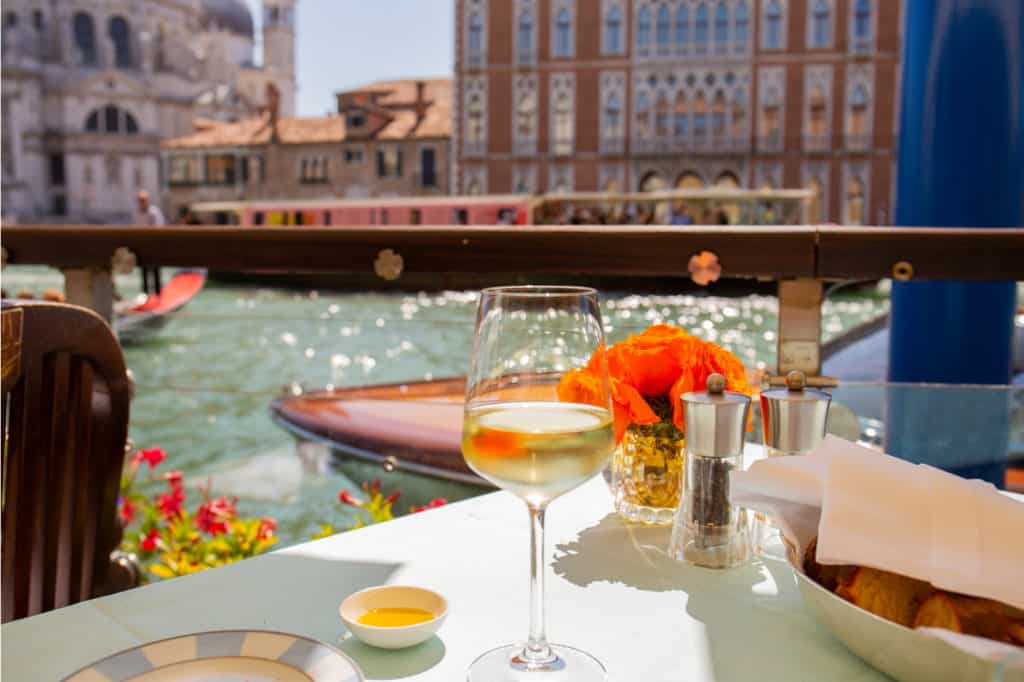
Food
- Guided Aperitivo Food Tour offers a 3.5-hour experience for $99.93 per person.
- The Rialto Bridge’s food market presents an array of fresh Italian produce and homemade pasta. Located in the San Polo sestiere shortly past the Rialto Bridge, the produce market is open Mondays-Saturdays and the fish market from Tuesdays to Saturdays from 7/730 a.m. to 1 p.m. or so, depending on when the vendors have sold their merchandise.
- Local Fish Market with Lunch and Wine offers a three-hour experience for $89.76 per person.
- Part of your Venetian food explorations should include experiencing Venice’s version of tapas, called cicchetti, at small wine shops called bacari. These can be found in all the city’s districts. One of the best bacari is Osteria All’Arco near the Rialto bridge.
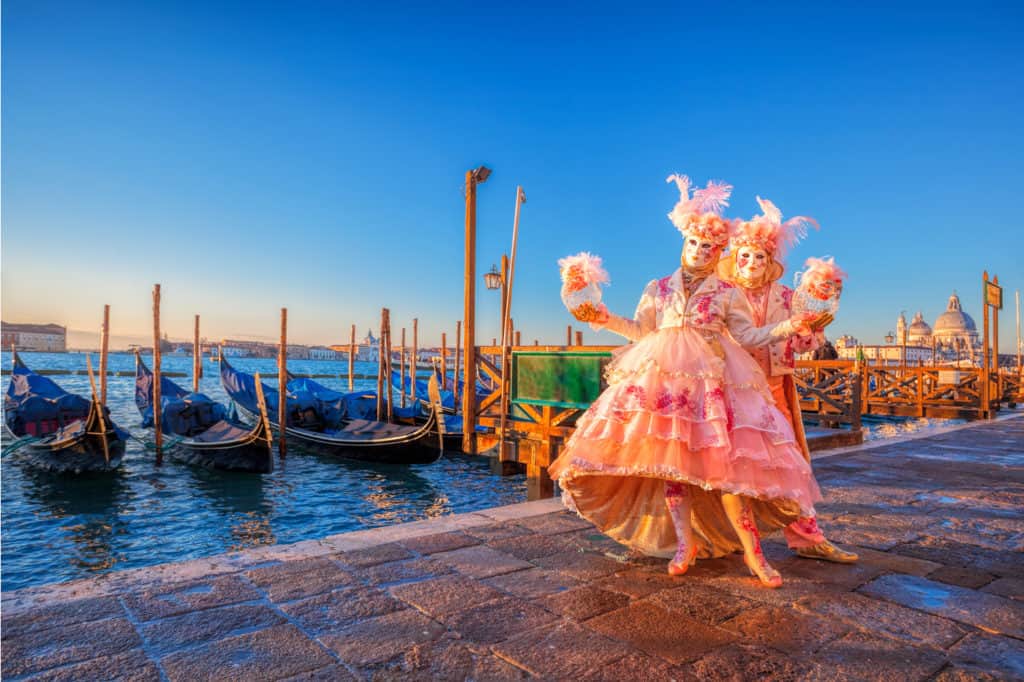
Events
When planning your trip to Venice, it helps to know when some of the city’s most famous events occur, so that you can time your visit to coincide (or avoid the crowds) during these times of year.
Carnevale
Join the costumed revelers at this famous pre-Lenten celebration when it seems the entire city’s population dons masks and elaborate attire to attend festivities and balls and participate in Europe’s most famous Carnivale. There are events in every district of the city. Dates vary depending on the timing of Easter, but it often falls in February.
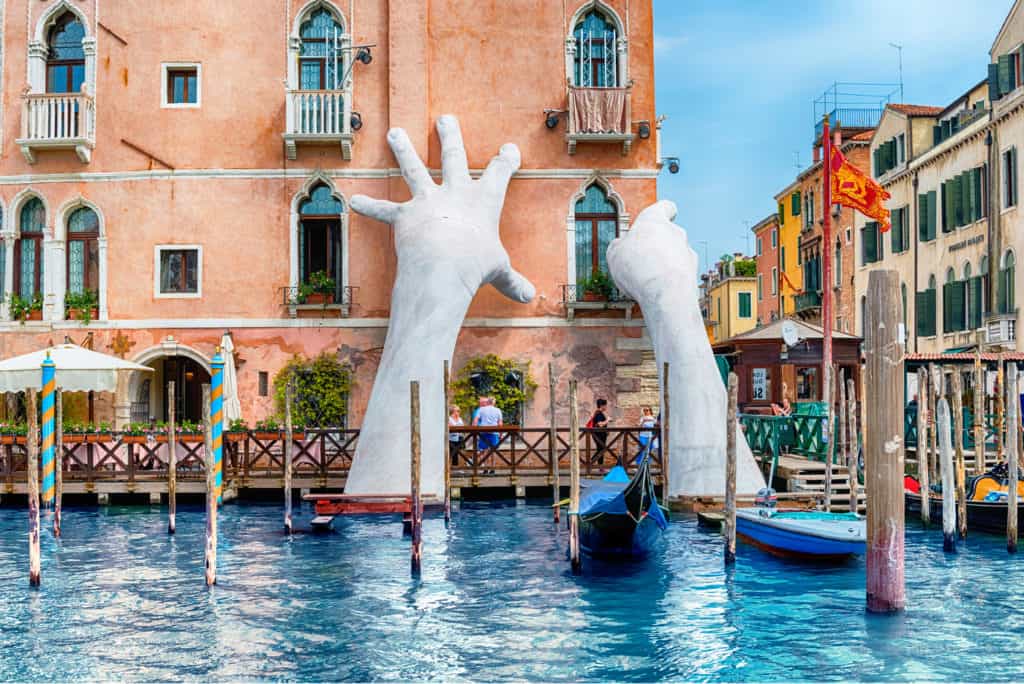
Venice Art Biennale
Running every other year from May to November and alternating with the Biennale Architettura, which focuses on architecture. The Biennale is a major event that brings world artistic or architectural focus to Venice during the exhibitions, which are held across the city.
The Biennale Architettura will be held in 2022, from April 23rd to November 27th.
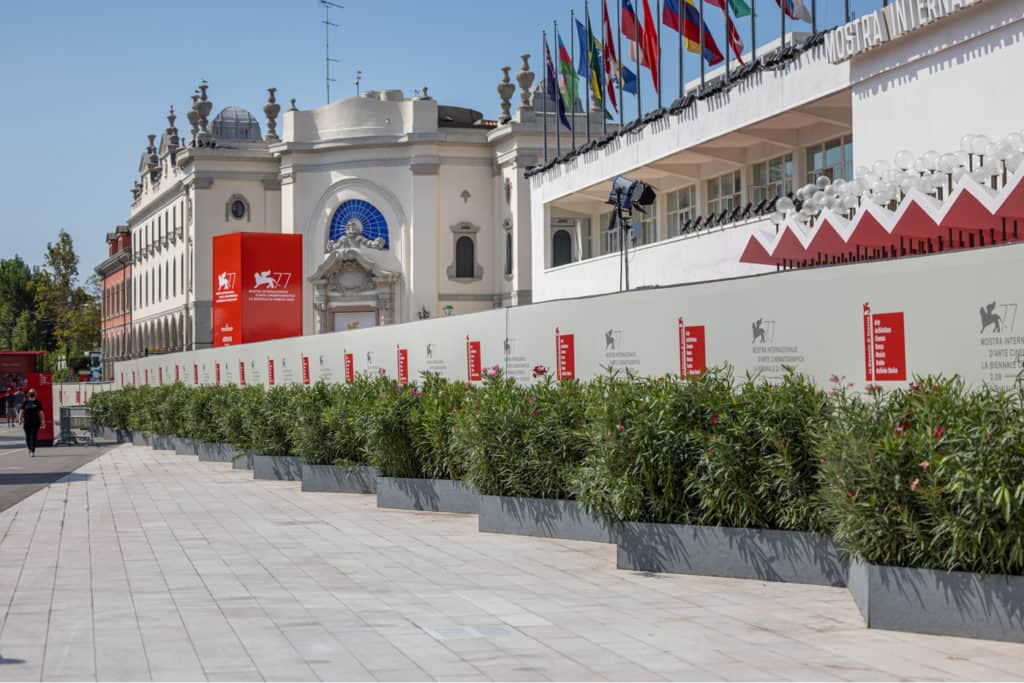
Venice International Film Festival
The glitterati from the world of film descend on the Lido from late August to early September for Venice’s own Film Festival, started in 1932. It is the oldest film festival in the world and awards he prestigious Golden Lion award as its top prize.
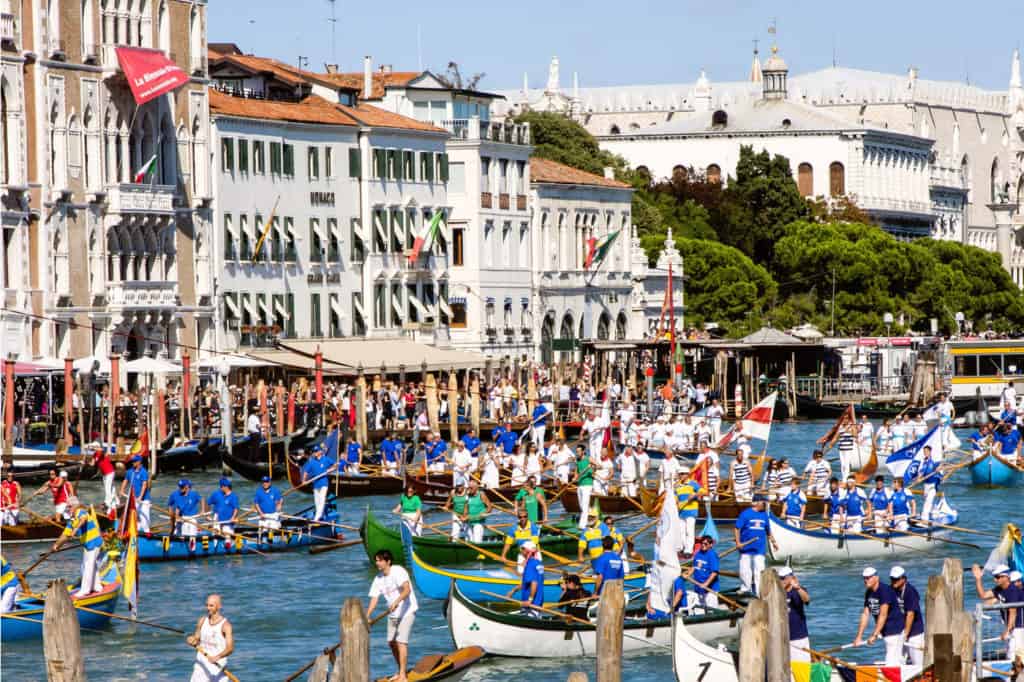
Historical Regatta
Held the first Sunday in September, this parade of elaborately decorated boats and individuals in costume reenact the water procession organized in 1489 to celebrate the return to Venice of Caterina Cornaro, a member of one of the most powerful families in Venice who had been married to the king of Cyprus.
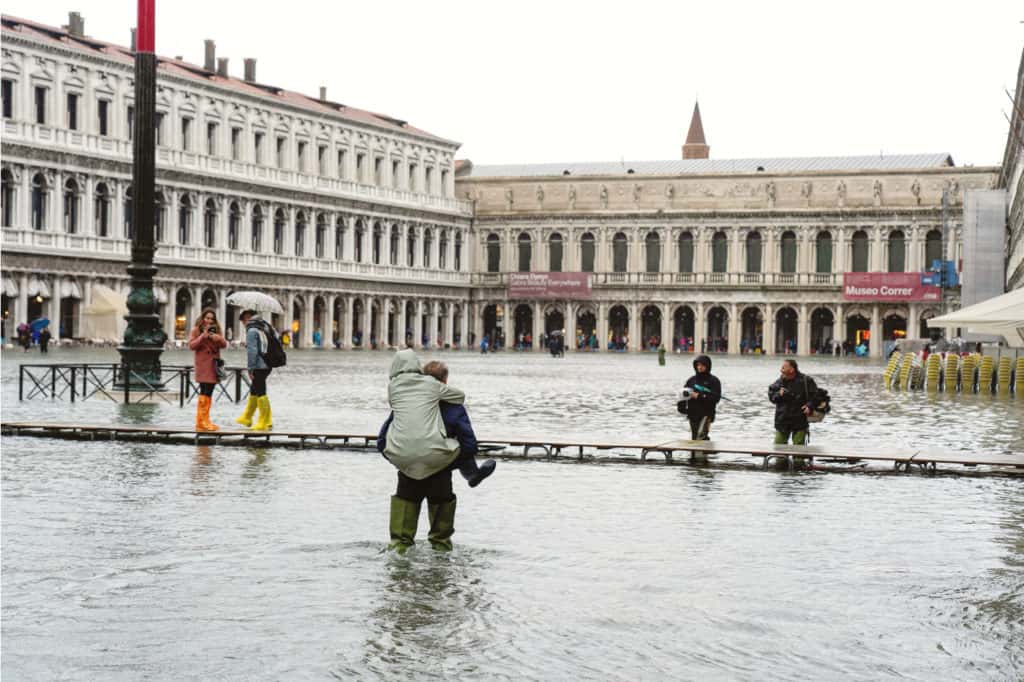
When not to go
Venice can cast its spell at any time of year but be aware that during the late fall to January, there can be the lagoon flooding called the Aqua Alta or high water, when Piazza San Marco and surrounding streets can be flooded. Boots are then the order of the day, and wooden boardwalks can be seen on the Square to help tourists and locals alike traverse the water’s invasion.
The summer months of July and August can be extremely crowded, with long lines at museums and attractions and seats on vaporetti difficult to come by. The spring and early fall may be better choices in terms of avoiding the aggravation of the densest tourist throngs.
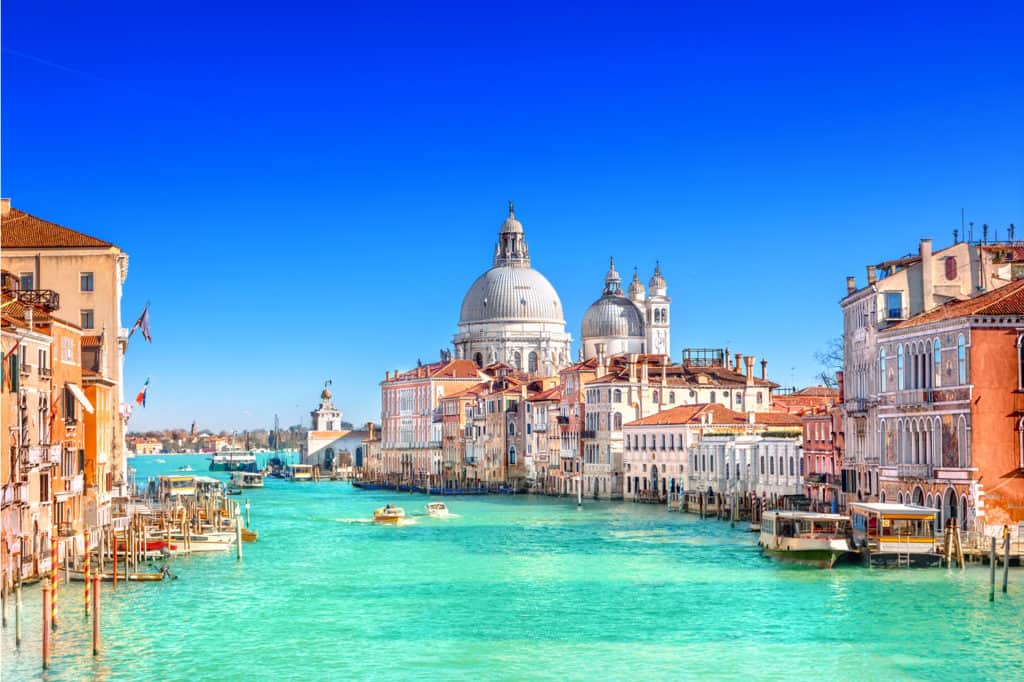
Conclusion
Visiting Venice is like a waking dream. The magical apparition of the city rising from the lagoon, stepping away from automotive traffic to the more peaceful (at least when without the crowds) means of moving about by boat or foot, and slowing down to appreciate the little comers of the city where residents live.
Getting lost can lead to some of your best discoveries, whether it is a little piazza where children play soccer, or a small canal side restaurant serving the freshest of fish. There will always be more to return for from the array of great museums to the staggering wealth of its churches, the various islands. And then there are the festivals like Carnevale, when reality takes a backseat to fantasy as locals and visitors alike can don masks and step out of character during the festivities. Venice is a banquet awaiting your arrival.
Related Articles on Italy
🇮🇹 Top Things to Do in Milan
🏛 23 Things to Do in Rome, Italy
💰 The Cost of Travel in Rome: A 2023 Budget Breakdown
🛬 How to Make the Most of a Layover in Venice
🍕 The Absolute Best Things to Do in Florence, Italy
🍹 21 Incredible Things to Do in Bologna, Italy
🍝 23 Magical Things to Do in Siena, Italy
🍷 16 Amazing Things to Do in Lucca, Italy
🎉 Liberazione: What to Expect From Italy’s Liberation Day

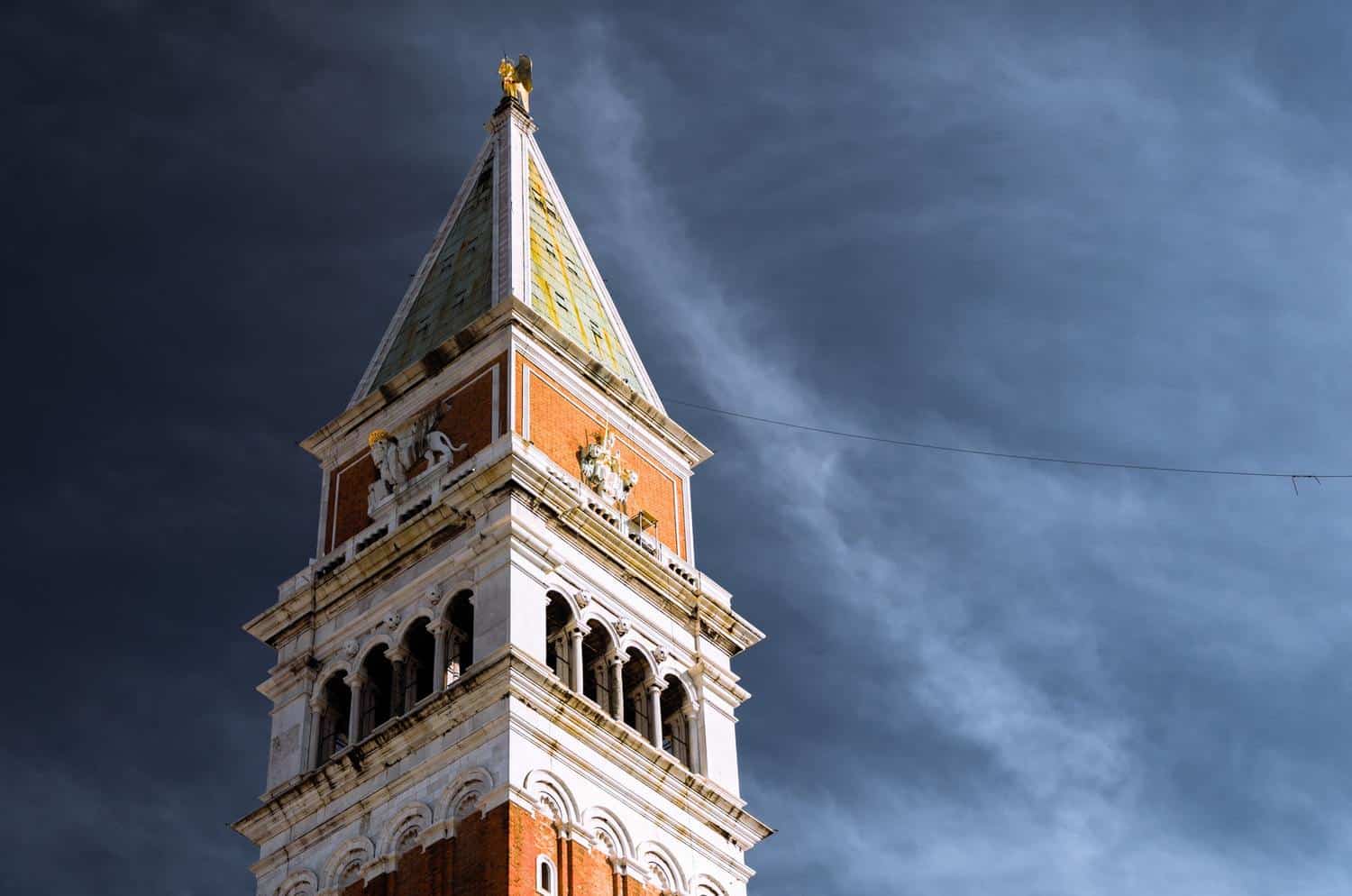



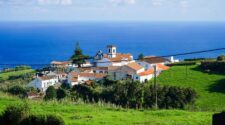
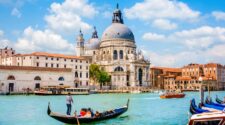

No Comment